- YACHTS FOR CHARTER
- DESTINATIONS

SAGITTA, YACHT FOR CHARTER

INQUIRE ABOUT SAGITTA
‘Sagitta’ is a 120.08ft /36.6m motor yacht built by Fiddi Angermeyer in 1961 and refitted in 1998.
Sagitta’s interior layout sleeps up to 16 guests in 10 rooms, 10 double cabins. She is also capable of carrying up to 8 crew onboard to ensure a relaxed luxury yacht experience. Timeless styling, beautiful furnishings and sumptuous seating feature throughout to create an elegant and comfortable atmosphere.
You’ll enjoy many leisure and entertainment facilities onboard, making her ideal for entertaining friends and family on your charter vacation. There’s plenty of space for enjoying an alfresco lunch or dinner on deck, or simply lounging in the sunshine and working on your tan.
Air conditioning keeps conditions comfortable throughout the cabins, even on the warmest of days or nights.
There’s a library onboard too so you can bury yourself into a great book as you go.
CHARTER SAGITTA
Similar luxury yachts for charter in.

La Pellegrina
$275,000/wk 164.04ft /50m 12 Guests 6 Cabins 10 Crew

€17,500/wk 72.18ft /22m 8 Guests 4 Cabins 3 Crew

€55,000/wk 116.83ft /35.61m 10 Guests 5 Cabins 5 Crew

Stella Nova
88.58ft /27m 8 Guests 4 Cabins 4 Crew

€14,000/wk 127.95ft /39m 22 Guests 10 Cabins 6 Crew

Royal Pelagic
127.99ft /39.01m 17 Guests 6 Cabins 9 Crew

Mystic Tide
$40,000/wk 85.99ft /26.21m 8 Guests 4 Cabins Crew

€160,000/wk 146.98ft /44.8m 12 Guests 6 Cabins 9 Crew

Midnight Rose
68.90ft /21m 8 Guests 4 Cabins 2 Crew

Metsuyan IV
€98,000/wk 118.77ft /36.2m 10 Guests 5 Cabins 7 Crew

€12,600/wk 98.43ft /30m 8 Guests 4 Cabins 4 Crew

€180,000/wk 178.05ft /54.27m 10 Guests 5 Cabins 10 Crew

127.95ft /39m 8 Guests 4 Cabins 8 Crew

$31,000/wk 75.98ft /23.16m 8 Guests 4 Cabins 3 Crew

Silver Wind
€155,000/wk 143.14ft /43.63m 8 Guests 4 Cabins 8 Crew

75.46ft /23m 7 Guests 3 Cabins 2 Crew

€168,000/wk 157.48ft /48m 10 Guests 5 Cabins 9 Crew

$52,000/wk 103.02ft /31.4m 10 Guests 5 Cabins 4 Crew

$105,000/wk 120.01ft /36.58m 10 Guests 5 Cabins 7 Crew

€25,900/wk 68.90ft /21m 6 Guests 3 Cabins 3 Crew

€329,000/wk 196.85ft /60m 12 Guests 7 Cabins 15 Crew

€25,900/wk 80.38ft /24.5m 8 Guests 4 Cabins 4 Crew

€49,000/wk 94ft /28.65m 8 Guests 4 Cabins 5 Crew

$100,000/wk 121.72ft /37.1m 12 Guests 5 Cabins 6 Crew

114.17ft /34.8m 6 Guests 3 Cabins 4 Crew

$85,000/wk 110.01ft /33.53m 9 Guests 4 Cabins 6 Crew

€100,000/wk 142.06ft /43.3m 10 Guests 5 Cabins 10 Crew

€550,000/wk 239.99ft /73.15m 12 Guests 8 Cabins 20 Crew

86.94ft /26.5m 8 Guests 4 Cabins 2 Crew

Necker Belle
$110,000/wk 104.99ft /32m 10 Guests 4 Cabins 7 Crew

The global authority in superyachting
- NEWSLETTERS
- Yachts Home
- The Superyacht Directory
- Yacht Reports
- Brokerage News
- The largest yachts in the world
- The Register
- Yacht Advice
- Yacht Design
- 12m to 24m yachts
- Monaco Yacht Show
- Builder Directory
- Designer Directory
- Interior Design Directory
- Naval Architect Directory
- Yachts for sale home
- Motor yachts
- Sailing yachts
- Explorer yachts
- Classic yachts
- Sale Broker Directory
- Charter Home
- Yachts for Charter
- Charter Destinations
- Charter Broker Directory
- Destinations Home
- Mediterranean
- South Pacific
- Rest of the World
- Boat Life Home
- Owners' Experiences
- Conservation and Philanthropy
- Interiors Suppliers
- Owners' Club
- Captains' Club
- BOAT Showcase
- Boat Presents
- Events Home
- World Superyacht Awards
- Superyacht Design Festival
- Design and Innovation Awards
- Young Designer of the Year Award
- Artistry and Craft Awards
- Explorer Yachts Summit
- Ocean Talks
- The Ocean Awards
- BOAT Connect
- Between the bays
- Golf Invitational
- BOATPro Home
- Superyacht Insight
- Global Order Book
- Premium Content
- Product Features
- Testimonials
- Pricing Plan
- Tenders & Equipment
SAGITTA is a 46.0 m Sail Yacht, built in Netherlands by Vitters and delivered in 2013.
Her top speed is 14.0 kn and her cruising speed is 10.0 kn and her power comes from two Caterpillar diesel engines. She can accommodate up to 8 guests, with 8 crew members waiting on their every need. She has a gross tonnage of 251.0 GT and a 9.0 m beam.
She was designed by Dubois Naval Architects , who also completed the naval architecture. Dubois Naval Architects has designed 77 yachts and created the naval architecture for 72 yachts for yachts above 24 metres.
Her interior was designed by Newcruise (7 other superyacht interiors designed) and Katharina Raczek (2 other superyacht interiors designed) - she is built with a Teak deck, a Aluminium hull, and Aluminium superstructure.
SAGITTA is in the top 30% by LOA in the world. She is one of 86 sailing yachts in the 45-50m size range, and, compared to similarly sized sailing yachts, her top speed is 0.69 kn above the average.
SAGITTA is currently sailing under the Malta flag, the 3rd most popular flag state for superyachts with a total of 1109 yachts registered. She is known to be an active superyacht and has most recently been spotted cruising near Spain. For more information regarding SAGITTA's movements, find out more about BOATPro AIS .
Specifications
- Name: SAGITTA
- Previous Names: GANESHA
- Yacht Type: Sail Yacht
- Builder: Vitters
- Naval Architect: Dubois Naval Architects
- Exterior Designer: Dubois Naval Architects
- Interior Designer: Newcruise , Katharina Raczek
Yacht featured in
Yachts like this, from our partners, sponsored listings.
- Innovative solutions
- Performance & comfort
- Our team & expertise
- Operation & heritage
- Your journey
- News & events
- Werken bij Vitters
Sagitta (ex Ganesha)

We dare to create unexpected connections.
Sagitta is a sloop rigged 46m performance cruiser designed by Dubois Naval Architects and interior architect Newcruise.
A specific technical feature is the cockpit with a fixed carbon bimini.
The vertically sliding curved glass windows can be moved up to enclose the cockpit area from the elements.
When sailing warmer seas, the deckhouse with the main companionway opened will be beautifully connected to the cockpit,
creating an unexpectedly spacious living area. Also the Vitters’ developed rudder feed-back system is a functional improvement.
It offers the feeling of the real helm, without the need for “sports club muscles”.
Type:
46m Performance Cruiser
Design:
Dubois Naval Architects
Interior Design:
Owner’s representative: .
A2B, Klaus Allebrodt
Length hull overall:
Delivery: .
Porta ipsum non lorem vestibulum, scelerisque dignissim eros ornare. Sed nisl risus, suscipit lacinia nunc et, mattis porta enim. Aliquam ornare est nec ante malesuada ultricies. Proin accumsan lorem ut nisl hendrerit, pulvinar cursus orci porta. Ut viverra metus odio, ac euismod orci imperdiet non. Aenean hendrerit ex commodo, tempus tortor sit amet, efficitur velit. Morbi maximus nisi sem, egetIn eu libero
Porta ipsum non
lorem vestibulum, scelerisque dignissim eros ornare. Sed nisl risus, suscipit lacinia nunc et, mattis porta enim. Aliquam ornare est
lorem vestibulum, scelerisque dignissim eros ornare. Sed nisl risus, suscipit lacinia nunc et,

Yachting Monthly
- Digital edition

Sagitta 30 review: Good performance and roomy accommodation
- David Harding
- January 26, 2024
If you’re after a 30-footer that combines offshore ability with shallow draught, good performance and roomy accommodation, a Sagitta 30 might fit the bill. David Harding explains why

Product Overview
For some monohull sailors, multihulls are still from a different planet, or perhaps even a different galaxy. Despite the increasing popularity and acceptance of catamarans as charter boats, many of the old preconceptions persist: multihulls don’t go to windward, they pitch and slam uncomfortably and, if you load them up for offshore sailing, they lose any speed advantage they might have had.
One man who has done more than most to prove that these notions are fallacies is Richard Woods. Involved with multihulls since the 1960s, he has designed dozens of catamarans (and a few trimarans) up to 69ft (21m). He has built and owned around 20 of them himself, and sailed tens of thousands of ocean and coastal miles in both his own designs and those of others.
Unlike some multihull enthusiasts, however, Richard hasn’t limited his activities to two or three hulls. He has raced and crossed oceans on monohulls – even designed a few – and continues to race performance dinghies. It’s fair to say his experience of sailing is quite extensive.

Richard Woods demonstrating the Sagitta’s balance from the upper helm seat. Photo: David Harding / SailingScenes.com
Until about 20 years ago, I used to pop down to Torpoint not infrequently to sail with Richard on his latest design. Torpoint, as any British multihull sailor will know, is the multihull Mecca of the UK – Millbrook Creek specifically. That’s where Pat and Pip Patterson ran the Multihull Centre and where Darren (Mr Dazcat) Newton and Simon Baker set up Multimarine before taking the Multihull Centre under their wing too. It used to be rare to see a single-hulled boat anywhere near Millbrook.
Millbrook is also where Richard lived when, in July 1991, he launched his new 30ft (9m) Sagitta catamaran. He and his then-wife and co-designer, Lilian, had spent two years building the wooden hulls as plugs, then making the moulds and finally building the first boat with materials that were cutting-edge in their day including biaxial and quadraxial glass and Divinycell foam.
Richard concentrated on the design work while Lilian did most of the building in a big tent in the back garden. At the bottom of the steeply sloping garden was a near vertical drop to the foreshore, so the biggest challenge of the entire process was to manhandle a structure 30ft long and 20ft wide through the trees, over the edge and down into the water.

With the relatively short, low coachroof and the mast stepped well aft, all sail controls are within reach of the cockpit. Photo: David Harding / SailingScenes.com
A good reception
The Sagitta was well received by the multihull world. Richard and Lilian sailed it widely, winning a good number of races (including the Fowey to Plymouth two-handed race at an average speed of 11 knots) and finishing second in class in the Round the Island Race.
The Woods rarely owned any of their own boats for more than three years, so in 1995 Sagitta – named as the first of the Sagitta class – was sold. The German owner sailed it to the Mediterranean and kept it there for a few years before selling it to English owners who sailed it back to the UK. A year almost to the day before my latest trip to Torpoint, Richard then bought it back: 32 years and several thousand sea-miles later, Sagitta returned to its first home and original owner.

Easy to raise and lower with uphauls and downhauls, the daggerboards give a performance advantage. Photo: David Harding / SailingScenes.com
Work in progress
In the intervening years, Richard had moved west to live in British Columbia, continuing to design, build and sail. We had been in touch periodically and, 18 months or so ago, I heard that he had returned to the UK. Then, while photographing the Round the Island Race from my RIB in July 2023, I noticed a catamaran called Sagitta passing in front of my lens during ‘that’ squall off The Needles (the one that led to at least three dismastings and 16 MOB incidents).
The last time I had seen Richard in that part of the world was when I joined him on his Eclipse 99 cat for the 2002 Round the Island Race.

Domed decks and coachroof give the Sagitta rounded lines. Re-painting the decks is still work in progress. Photo: David Harding / SailingScenes.com
Partly as a result of the 2023 photos, I found myself in Torpoint a few months later aboard Sagitta, on which Richard had been working since buying it back. It was very much a matter of work in progress, but the boat was fully functional and flying the new sails from Highwater in Plymouth that had taken it around the island faster than a lot of 35-40ft monohulls.
Under its previous ownership, Richard reckons it hadn’t been sailed that seriously. ‘When I bought it, it had no spinnaker, but three corkscrews and a big bottle rack.’
Russian roots
Richard had come up with the idea for the design of Sagitta during his ‘Day Sail To Russia’ in 1989, when he, Lilian and Stuart Fisher had each sailed one of the Woods-designed 24ft (7.3m) Strider cats singlehanded in company from Plymouth to Tallinn (then in the USSR) in a series of day-hops.
He had wanted a new design that was big, fast and comfortable enough to sail offshore yet small enough for a two-handed crew to manage easily. As with his earlier designs, he gave it rounded hulls with a fairly high prismatic coefficient (i.e. full ends) to minimise pitching and ensure good performance in stronger winds.
Article continues below…

Monohull or multihull: which is best for blue water?
As former editor of Yachting World, David Glenn has plenty of experience of both monohull and multihull cruising. Here he…

Best multihulls: We pick the best two and three hulled yachts
Few of us can have failed to see the rapid growth of interest in multihulls and this formerly niche sector…
It also features a knuckle above the waterline to increase buoyancy, create internal space and deflect spray while keeping wetted area to a minimum. Generous freeboard should ensure a dry ride, with the flared topsides contributing to ultimate stability (Richard came away from studying yacht design at the Southampton Institute in the 1970s with distinctions in design, structures and stability, and has sat on the ISO stability committee and the Small Craft Advisory Working Group of the MCA).
Other features of the Sagitta include a relatively short, high bridgedeck that starts well aft to avoid slamming. The coachroof is lower than on many cats for easy access to the sail-control hardware together with good visibility from the helm, as well as to reduce weight and windage. It still allows comfortable sitting headroom in the saloon.

A vast cockpit for a 30ft cruising yacht. The beam allows two doors, for easy access to the saloon and both hulls. Photo: David Harding / SailingScenes.com
High or low
Richard’s Sagitta has a sizeable rig with a square-top main, paired below the waterline with daggerboards. The idea behind the design was that it could be tuned up or down depending on whether an owner was interested principally in racing, cruising or performance cruising. Other Sagittas, including many of those built as production boats in South Africa, have LAR (low aspect-ratio) keels and more modest rigs.
For performance, there’s no doubt that daggerboards give more than a slight edge. They also reduce pitching by minimising extra buoyancy amidships and, with the kick-up rudders, they mean less draught in creek-crawling mode.
Despite the tall rig and generous sail area, Richard designed the Sagitta to carry full canvas in up to 25 knots of apparent wind, or occasionally more in race mode. The beam of 19ft 6in (5.95m) provides a lot of power and avoids drag-inducing interaction of the wave patterns between the hulls. It also gives an enormous cockpit. One of the boat’s first outings 30 years ago was with 12 people for a day sail, and they still hit 16 knots.

Shallow draught, good performance are hall-marks of the Sagitta 30. Photo: David Harding / SailingScenes.com
On the day of our test sail from Torpoint, there were just four of us so we had vast amounts of space in the cockpit. At the helm you can sit on the seat atop the guardrails to see over the coachroof. Alternatively, hinge the seat down as a backrest, sit on the deck and look forward through the doors (one each side leading from cockpit to saloon) and the windows in the coachroof.
As befits a boat of this nature, the Sagitta has tiller steering for simplicity and a direct feel. It also means you can always sit on the windward side for the best visibility forward. There’s a tiller extension on each end of the bar linking the two short tillers, so when you tack you clip one extension back on to the bar, hike across to the other side and pick up the new extension. Thankfully the Sagitta tacks positively – with the daggerboards at least – so, as long as you’re not indecisive with the helm, you don’t have to scuttle across too madly.
Tiller steering also keeps you close to the mainsheet which, together with the Sailspar continuous furler for the screecher (Code 0), came from one of Richard’s 34ft Banshee designs in 1988. Naturally there’s a full-width traveller to help control twist downwind.

A vertical batten in the foot of the jib maximises sail area over the foredeck and coachroof. Photo: David Harding / SailingScenes.com
Control centre
Most of the rest of the sail controls are on the coachroof by the foot of the mast, which is only a couple of feet forward of the cockpit. About the only occasion you would have to go on deck is to hoist the spinnaker or when anchoring or mooring. There’s plenty to hang on to, though the domed decks and coachroof mean few flat surfaces under foot.
Forward of the coachroof are a multitude of deck lockers for sails and the anchor, then of course the trampoline between the forward beam and the bridgedeck. From here you can fully appreciate the way the headsail has been cut, complete with a vertical batten in the foot, to maximise its area by hugging the deck and then sweeping up over the coachroof.
In 14-16 knots of wind from the south-southwest that kicked up a lumpy sea beyond the breakwater, we had enough canvas to get Sagitta going nicely, even if at barely half throttle. On a reach we slipped along at 7-8 knots most of the time, which is not bad for a 30ft cruising boat. Richard makes the point that, in a multihull under 40ft, living, cooking, sleeping and navigating at speeds over 8 knots can become uncomfortable.

The saloon is not dissimilar in size to that on a monohull, only aligned athwartships. It can be converted to a single berth, or a large double with the second table (not in use here). Photo: David Harding / SailingScenes.com
In any event, swallowing miles on passage is all about average rather than peak speeds and how hard you have to work to achieve them.
That inevitably led to a discussion about how, on the way around the island with Eclipse in 2002, with a crew of four and a china teapot in the galley, we had found ourselves overtaking Mumm 30s on the beat to the finish.
Richard subsequently had to abandon Eclipse in a Pacific storm so violent that a 450ft US frigate wouldn’t come anywhere near. Eclipse was later found, upright and unscathed, but that’s another story.

Much of the starboard hull is devoted to the galley. Photo: David Harding / SailingScenes.com
Two decades later, beating into the Plymouth chop on Sagitta, we made 5.5 to 6.5 knots with minimal pitching and no slamming, so life was pretty comfortable.
It also helped that the helm was finger-light and directional stability pretty good. Little effort is needed to keep the boat on track, and a modest autopilot will suffice.
Below decks
The layout on Sagitta was born of many miles’ sailing experience. Richard prefers to have the chart table in a hull rather than on the bridgedeck, so it’s to port between the double berth in the stern and the heads and wet-locker forward.

The nav station is in the middle of the port hull, abaft the heads and wet locker. Photo: David Harding / SailingScenes.com
The bow sections of each hull were originally devoted to stowage, reached via deck hatches, but a previous owner had cut away the full-width bulkhead in the starboard hull at the forward end of the galley to create an extra berth. That resulted in cracking in remaining parts of the bulkhead, highlighting the risk of making alterations that have structural implications without seeking the advice of the designer or builder.
Another double berth is aft in the starboard hull, leaving the bridgedeck for seating and the saloon table. The saloon gives an all-round view, which we enjoyed when back on the mooring indulging in a cream tea (naturally in both Devon and Cornish styles, since we had one hull in each county).
Enjoyed reading this?
A subscription to Yachting Monthly magazine costs around 40% less than the cover price .
Print and digital editions are available through Magazines Direct – where you can also find the latest deals .
YM is packed with information to help you get the most from your time on the water.
- Take your seamanship to the next level with tips, advice and skills from our experts
- Impartial in-depth reviews of the latest yachts and equipment
- Cruising guides to help you reach those dream destinations
Follow us on Facebook , Twitter and Instagram.
For all their logic, catamarans still aren’t everyone’s cup of tea. But if your only experience of two hulls has been on a charter cat that looks like a multi-storey car park (and has the sailing qualities to match), you would find a boat like the Sagitta a revelation. It might not match a Farrier or Dragonfly trimaran for performance in most conditions, but covers the ground pretty efficiently all the same and provides far more living space. The Sagitta is definitely a boat that could convert a few monohull sailors to the pleasures of sailing fast, comfortably and upright in a catamaran.
- Yachts for sale
- Yachts for charter
- Brokerage News

- Yacht Harbour
- Yacht Sagitta
About Sagitta
Contact agent, specifications.
Similar yachts New listings academia research writing testThe 10 best websites to find academic writing jobs.  Your changes have been saved Email is sent Email has already been sent Please verify your email address. You’ve reached your account maximum for followed topics. Why I Stopped Playing Wordle and Started Using This Puzzle Website InsteadAre your productivity tools just cleverly disguised procrastination, why i'm leaving gmail and using this security-focused email service instead. If you're a student looking for some extra dough, academic writing is one of the best ways to encash your skills. At the same time, it enhances your knowledge and helps you grow as a learner. In fact, it's not just for students; you can do it full-time if you are a professional writer. Having the freedom to work from home, at your own pace, and having opportunities to grow are just a few perks of this job. So, if you are ready to delve deeper, let's look at ten great websites for finding academic writing jobs. 1. WritingCreek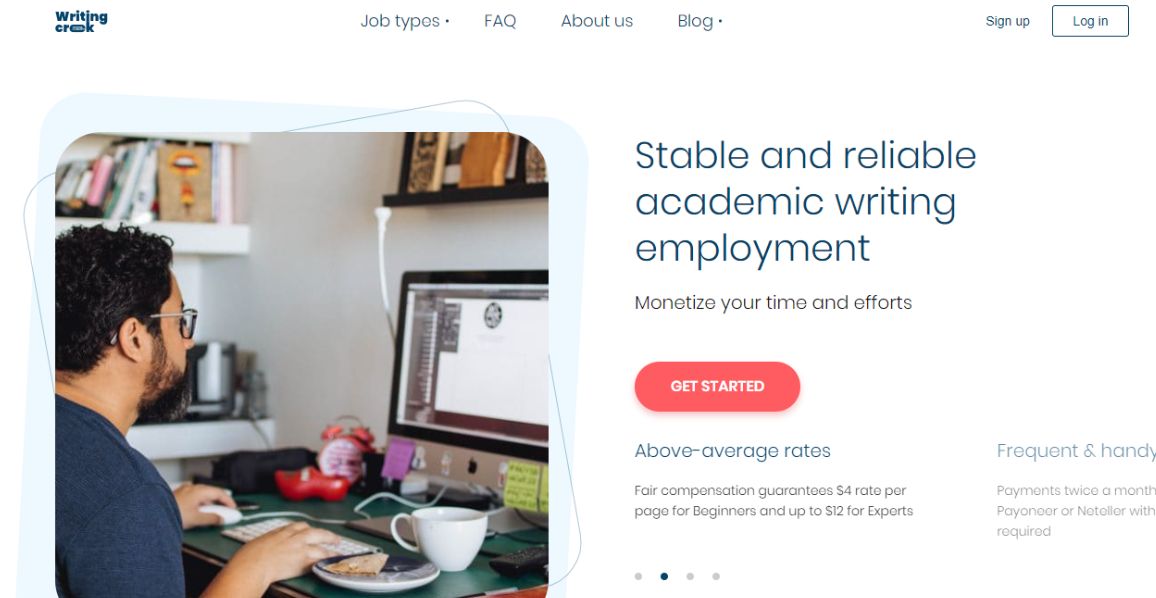 WritingCreek is one of the best academic writing sites to work with if you are a beginner. It has a simple and free-of-cost hiring process, which usually takes 24 to 48 hours to complete. Once the team approves your account, you can start bidding and earning straight away. It offers a rate of $4.00 per page to beginners and up to $12.00 to experts. The site lets you choose the subjects you are proficient in and has a regular stream of academic tasks with short and long deadlines. WritingCreek gives you the liberty to choose your tasks and work at your own pace, and its support team is always available for a live chat whenever you need them. It also helps you enhance your skills as its in-house editors give feedback on the papers accepted by the client, offering useful tips for improvement. WritingCreek usually pays twice a month through different payment methods like Payoneer and PayPal without deducting any extra charges. You can also check out these technical writing jobs if you have the expertise. 2. EssayShark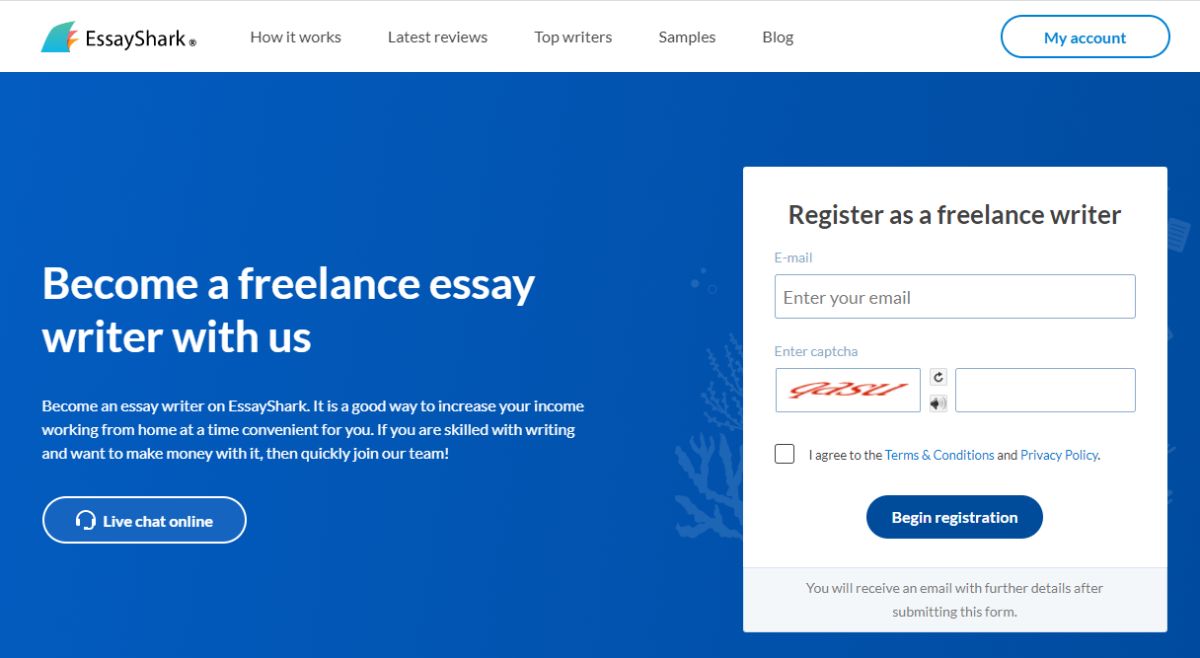 You can get started on EssayShark within a week after taking and passing its test. If you are a college student and have solid writing skills, this platform can help you earn a decent amount to aid you in your studies. The site lets you bid on papers that fall under your subject area. You can choose your preferred subjects in advance to get relevant tasks and can chat with the customers directly to discuss the details of the paper. EssayShark pays you twice a month, and along with the pay, it also offers bonuses and rewards if the customers give you good ratings because of your timely submissions and high-quality work. 3. Writers.ph Being among the top academic writing websites, this platform targets professional-level writers and researchers to work for them. It usually takes 24 to 48 hours to review your application, and once approved, you can start working immediately. The site gets projects from all around the world and has a constant flow of work. It also offers 24/7 support to help you with any issues that you might face. In addition, Writers.ph offers job promotions based on your performance, leading to status improvement and increased pay rates. It also has proofreading, editing, and presentation-related tasks, along with academic paper writing. Also, check out these great smartphone apps for freelance writers . 4. LancerHop LancerHop provides you with multiple fields to work in. It hires academic writers, web developers, editing experts, web content writers, copywriters, editing experts, and bloggers. The hiring process is similar to that of other academic writing websites, where you need to create a profile, and after passing the test, you can start working. It creates a dashboard where the system assigns you tasks. All of your information regarding payment, task completion, and editing is available on the dashboard. The platform allows you to set flexible timings for your work by choosing from different time zones and also flexible working days like weekdays only. 5. Academia Research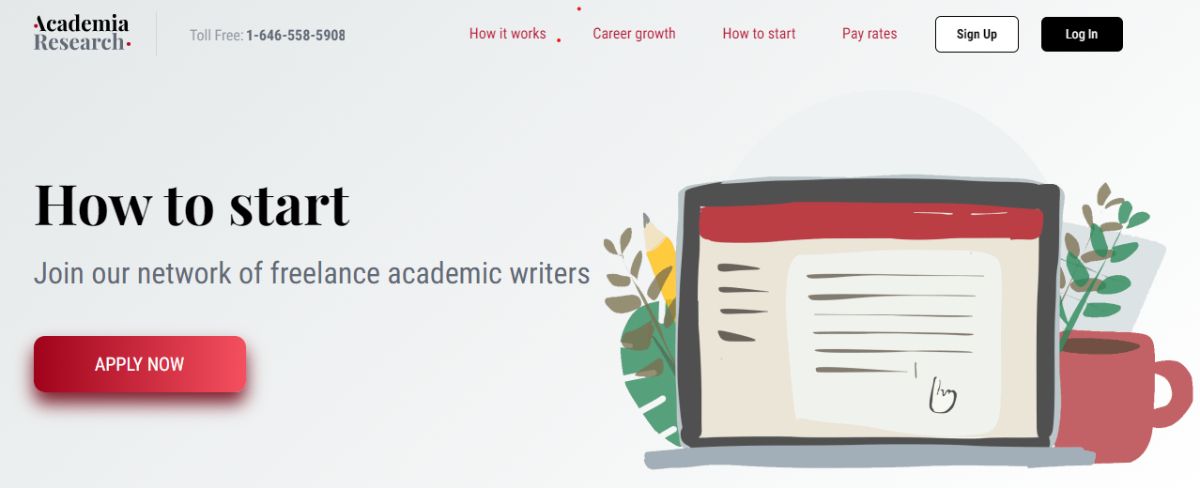 Academia Research offers you decent pay rates and career growth opportunities in the academic writing field. The registration process requires a test to get selected. Once the team approves your account, you start at a General level, where the pay is $3.00 per page for high school and college level papers. You can move on to Advanced, Premium, and First Class levels to get paid $2.00 per page for master's and Ph.D. level papers. The site has a variety of tasks with flexible deadlines related to different subjects and education levels. It pays you twice a month through the payment method of your choice. 6. Essay Service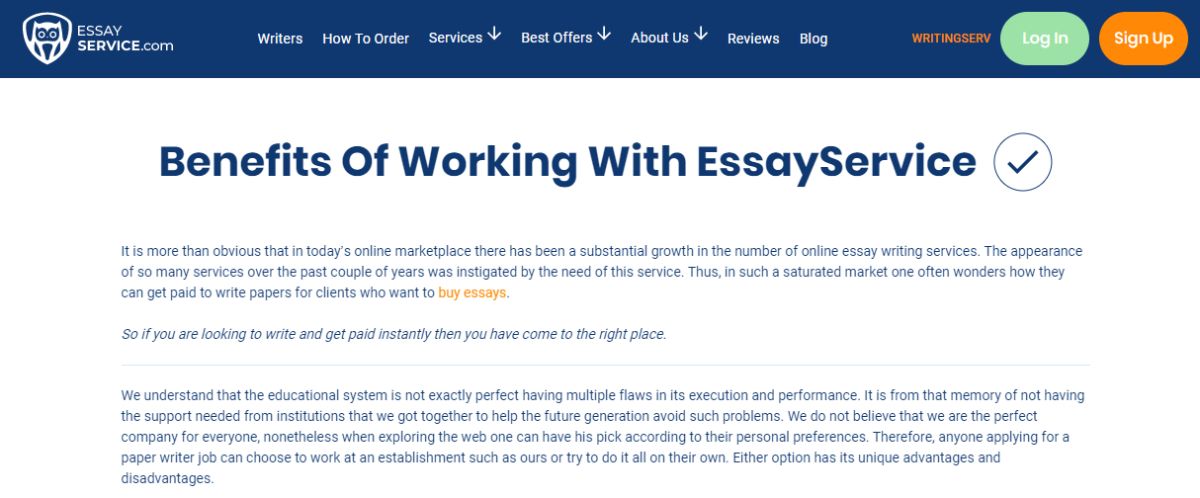 This platform provides you with an easy-to-use website with a mobile-friendly interface to let you access your account from anywhere. Moreover, it has an efficient system for competitive bidding that also offers a price negotiation facility. Essay Service helps you build a career and a network, and you can share your professional portfolio with your clients and other contacts, helping you expand your customer base in the process. You also get a 24/7 online support system to guide you at each step. You can withdraw money every 48 hours through Skrill or wire transfer. In addition, it lets you stay connected through SMS, email, and push notifications without needing to go online. 7. Writers Labs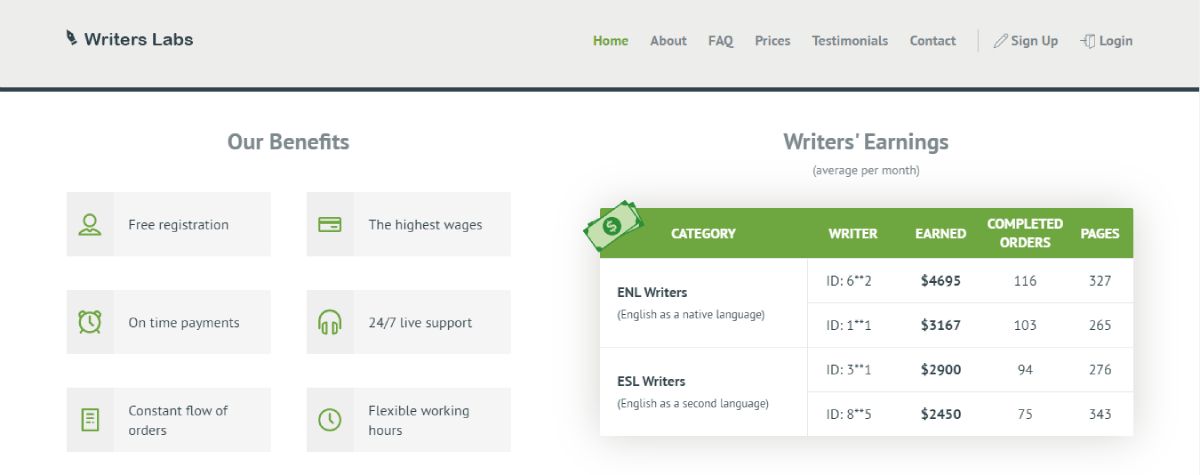 Writers Labs provides you with a variety of opportunities, including academic writing, article writing, and essay writing. Its pay rates are pretty decent, varying from $5.00 to $26.00 for one page, and it also offers a 2% to 4% bonus on high efficiency. You get a list of tasks on the site and can choose from those tasks based on your preference and availability. In addition, its support team is there to guide you through the process to help you get started. Check out these ways to source clients as a freelance writer . 8. Write My Essay Online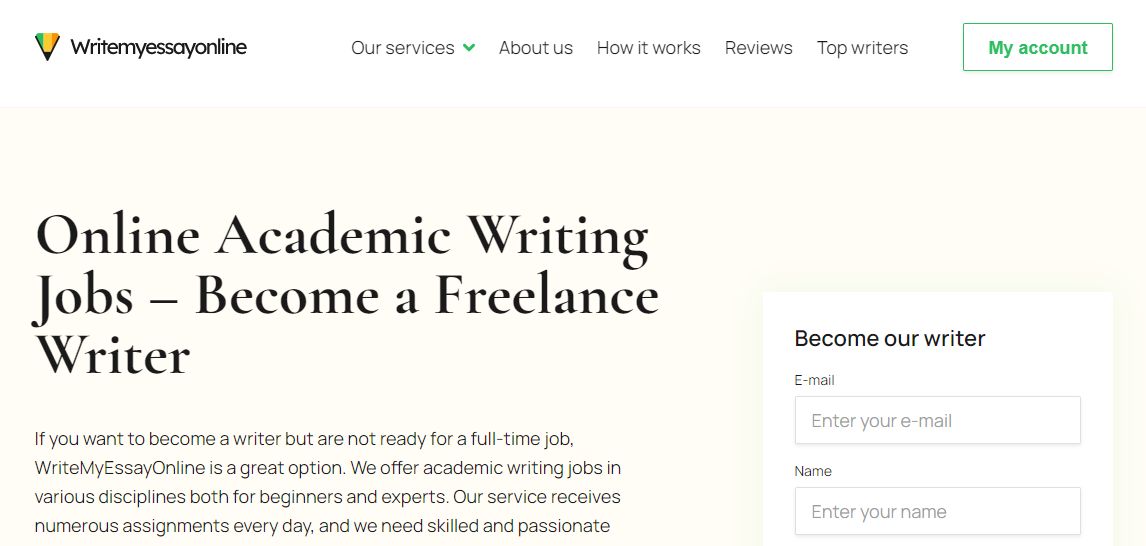 Write My Essay Online is a platform suitable for both academic writing beginners and experts. The website has a regular influx of tasks and helps you get assignments in the areas of your interest. Registration on this website is free, much like on most sites on this list, and it has flexible work timing, allowing you to choose your projects as per your desire. Through bidding, you can decide your own rates and get paid twice a month. 9. Academic Minds Academic Minds provides numerous services to help you unleash your academic writing potential. You have the option of taking up multiple roles, like tutoring, marking work, writing essays and dissertations, and editing. The website is UK based and helps international students in excelling in their academic tasks. You can start bidding once your account is completely set up, and there is a potential to earn as much as $4000.00 per month through dissertations and tutoring. You can also showcase your online writing portfolio on these free platforms . 10. WriterBay WriterBay provides you with projects and assignments in numerous fields. It has a free lifetime membership that offers a platform where you can get long-term work. After registering with WriterBay, you can manage the workload at your own pace. In addition, it offers competitive pay and opportunities for personal growth. Most of its services are similar to those offered by other sites on this list. Find Your Next Academic Job Through These SitesAcademic writing jobs provide a valuable opportunity for learning and growth. It is a huge field of work that allows you to earn and grow in your career. Most of the websites shared above help you earn well and offer flexible timings for easier management. You can choose one or more of these sites to move forward while enjoying the rewards from the comfort of your home.
 The best AI tools for research papers and academic research (Literature review, grants, PDFs and more)As our collective understanding and application of artificial intelligence (AI) continues to evolve, so too does the realm of academic research. Some people are scared by it while others are openly embracing the change. Make no mistake, AI is here to stay! Instead of tirelessly scrolling through hundreds of PDFs, a powerful AI tool comes to your rescue, summarizing key information in your research papers. Instead of manually combing through citations and conducting literature reviews, an AI research assistant proficiently handles these tasks. These aren’t futuristic dreams, but today’s reality. Welcome to the transformative world of AI-powered research tools! This blog post will dive deeper into these tools, providing a detailed review of how AI is revolutionizing academic research. We’ll look at the tools that can make your literature review process less tedious, your search for relevant papers more precise, and your overall research process more efficient and fruitful. I know that I wish these were around during my time in academia. It can be quite confronting when trying to work out what ones you should and shouldn’t use. A new one seems to be coming out every day! Here is everything you need to know about AI for academic research and the ones I have personally trialed on my YouTube channel. My Top AI Tools for Researchers and Academics – Tested and Reviewed!There are many different tools now available on the market but there are only a handful that are specifically designed with researchers and academics as their primary user. These are my recommendations that’ll cover almost everything that you’ll want to do:
Want to find out all of the tools that you could use? Here they are, below: AI literature search and mapping – best AI tools for a literature review – elicit and moreHarnessing AI tools for literature reviews and mapping brings a new level of efficiency and precision to academic research. No longer do you have to spend hours looking in obscure research databases to find what you need! AI-powered tools like Semantic Scholar and elicit.org use sophisticated search engines to quickly identify relevant papers. They can mine key information from countless PDFs, drastically reducing research time. You can even search with semantic questions, rather than having to deal with key words etc. With AI as your research assistant, you can navigate the vast sea of scientific research with ease, uncovering citations and focusing on academic writing. It’s a revolutionary way to take on literature reviews.
If you like AI tools you may want to check out this article:
AI-powered research tools and AI for academic researchAI research tools, like Concensus, offer immense benefits in scientific research. Here are the general AI-powered tools for academic research. These AI-powered tools can efficiently summarize PDFs, extract key information, and perform AI-powered searches, and much more. Some are even working towards adding your own data base of files to ask questions from. Tools like scite even analyze citations in depth, while AI models like ChatGPT elicit new perspectives. The result? The research process, previously a grueling endeavor, becomes significantly streamlined, offering you time for deeper exploration and understanding. Say goodbye to traditional struggles, and hello to your new AI research assistant!
AI for reading peer-reviewed papers easilyUsing AI tools like Explain paper and Humata can significantly enhance your engagement with peer-reviewed papers. I always used to skip over the details of the papers because I had reached saturation point with the information coming in. These AI-powered research tools provide succinct summaries, saving you from sifting through extensive PDFs – no more boring nights trying to figure out which papers are the most important ones for you to read! They not only facilitate efficient literature reviews by presenting key information, but also find overlooked insights. With AI, deciphering complex citations and accelerating research has never been easier.
AI for scientific writing and research papersIn the ever-evolving realm of academic research, AI tools are increasingly taking center stage. Enter Paper Wizard, Jenny.AI, and Wisio – these groundbreaking platforms are set to revolutionize the way we approach scientific writing. Together, these AI tools are pioneering a new era of efficient, streamlined scientific writing.
AI academic editing toolsIn the realm of scientific writing and editing, artificial intelligence (AI) tools are making a world of difference, offering precision and efficiency like never before. Consider tools such as Paper Pal, Writefull, and Trinka. Together, these tools usher in a new era of scientific writing, where AI is your dedicated partner in the quest for impeccable composition.
AI tools for grant writingIn the challenging realm of science grant writing, two innovative AI tools are making waves: Granted AI and Grantable. These platforms are game-changers, leveraging the power of artificial intelligence to streamline and enhance the grant application process. Granted AI, an intelligent tool, uses AI algorithms to simplify the process of finding, applying, and managing grants. Meanwhile, Grantable offers a platform that automates and organizes grant application processes, making it easier than ever to secure funding. Together, these tools are transforming the way we approach grant writing, using the power of AI to turn a complex, often arduous task into a more manageable, efficient, and successful endeavor.
Best free AI research toolsThere are many different tools online that are emerging for researchers to be able to streamline their research processes. There’s no need for convience to come at a massive cost and break the bank. The best free ones at time of writing are:
Wrapping upThe integration of artificial intelligence in the world of academic research is nothing short of revolutionary. With the array of AI tools we’ve explored today – from research and mapping, literature review, peer-reviewed papers reading, scientific writing, to academic editing and grant writing – the landscape of research is significantly transformed. The advantages that AI-powered research tools bring to the table – efficiency, precision, time saving, and a more streamlined process – cannot be overstated. These AI research tools aren’t just about convenience; they are transforming the way we conduct and comprehend research. They liberate researchers from the clutches of tedium and overwhelm, allowing for more space for deep exploration, innovative thinking, and in-depth comprehension. Whether you’re an experienced academic researcher or a student just starting out, these tools provide indispensable aid in your research journey. And with a suite of free AI tools also available, there is no reason to not explore and embrace this AI revolution in academic research. We are on the precipice of a new era of academic research, one where AI and human ingenuity work in tandem for richer, more profound scientific exploration. The future of research is here, and it is smart, efficient, and AI-powered. Before we get too excited however, let us remember that AI tools are meant to be our assistants, not our masters. As we engage with these advanced technologies, let’s not lose sight of the human intellect, intuition, and imagination that form the heart of all meaningful research. Happy researching! Thank you to Ivan Aguilar – Ph.D. Student at SFU (Simon Fraser University), for starting this list for me!  Dr Andrew Stapleton has a Masters and PhD in Chemistry from the UK and Australia. He has many years of research experience and has worked as a Postdoctoral Fellow and Associate at a number of Universities. Although having secured funding for his own research, he left academia to help others with his YouTube channel all about the inner workings of academia and how to make it work for you. Thank you for visiting Academia Insider.We are here to help you navigate Academia as painlessly as possible. We are supported by our readers and by visiting you are helping us earn a small amount through ads and affiliate revenue - Thank you!  2024 © Academia Insider  Have a language expert improve your writingRun a free plagiarism check in 10 minutes, generate accurate citations for free.
Writing Strong Research Questions | Criteria & ExamplesPublished on October 26, 2022 by Shona McCombes . Revised on November 21, 2023. A research question pinpoints exactly what you want to find out in your work. A good research question is essential to guide your research paper , dissertation , or thesis . All research questions should be:
 Table of contentsHow to write a research question, what makes a strong research question, using sub-questions to strengthen your main research question, research questions quiz, other interesting articles, frequently asked questions about research questions. You can follow these steps to develop a strong research question:
The way you frame your question depends on what your research aims to achieve. The table below shows some examples of how you might formulate questions for different purposes.
Using your research problem to develop your research question
Note that while most research questions can be answered with various types of research , the way you frame your question should help determine your choices. Receive feedback on language, structure, and formattingProfessional editors proofread and edit your paper by focusing on:
See an example  Research questions anchor your whole project, so it’s important to spend some time refining them. The criteria below can help you evaluate the strength of your research question. Focused and researchable
Feasible and specific
Complex and arguable
Relevant and original
Chances are that your main research question likely can’t be answered all at once. That’s why sub-questions are important: they allow you to answer your main question in a step-by-step manner. Good sub-questions should be:
Here are a few examples of descriptive and framing questions:
Keep in mind that sub-questions are by no means mandatory. They should only be asked if you need the findings to answer your main question. If your main question is simple enough to stand on its own, it’s okay to skip the sub-question part. As a rule of thumb, the more complex your subject, the more sub-questions you’ll need. Try to limit yourself to 4 or 5 sub-questions, maximum. If you feel you need more than this, it may be indication that your main research question is not sufficiently specific. In this case, it’s is better to revisit your problem statement and try to tighten your main question up. Prevent plagiarism. Run a free check.If you want to know more about the research process , methodology , research bias , or statistics , make sure to check out some of our other articles with explanations and examples. Methodology
Statistics
Research bias
The way you present your research problem in your introduction varies depending on the nature of your research paper . A research paper that presents a sustained argument will usually encapsulate this argument in a thesis statement . A research paper designed to present the results of empirical research tends to present a research question that it seeks to answer. It may also include a hypothesis —a prediction that will be confirmed or disproved by your research. As you cannot possibly read every source related to your topic, it’s important to evaluate sources to assess their relevance. Use preliminary evaluation to determine whether a source is worth examining in more depth. This involves:
A research hypothesis is your proposed answer to your research question. The research hypothesis usually includes an explanation (“ x affects y because …”). A statistical hypothesis, on the other hand, is a mathematical statement about a population parameter. Statistical hypotheses always come in pairs: the null and alternative hypotheses . In a well-designed study , the statistical hypotheses correspond logically to the research hypothesis.  Formulating a main research question can be a difficult task. Overall, your question should contribute to solving the problem that you have defined in your problem statement . However, it should also fulfill criteria in three main areas:
Cite this Scribbr articleIf you want to cite this source, you can copy and paste the citation or click the “Cite this Scribbr article” button to automatically add the citation to our free Citation Generator. McCombes, S. (2023, November 21). Writing Strong Research Questions | Criteria & Examples. Scribbr. Retrieved August 21, 2024, from https://www.scribbr.com/research-process/research-questions/ Is this article helpful?Shona McCombesOther students also liked, how to define a research problem | ideas & examples, how to write a problem statement | guide & examples, 10 research question examples to guide your research project, "i thought ai proofreading was useless but..". I've been using Scribbr for years now and I know it's a service that won't disappoint. It does a good job spotting mistakes” ENGL002: English Composition IICourse Introduction
The intent of this course is to teach you how to prepare research for any discipline or subject. We will carefully explore and practice general research techniques and processes that you should apply to many academic disciplines and in your job. In Unit 1, you will select a topic that intrigues you, conduct preliminary research to focus your topic, and develop a thesis statement and a set of questions to help guide the remainder of your research. In Unit 2, you will learn strategies for conducting your research and taking careful notes. We will look carefully at researching on the Internet, but we will also make a point of honing the skills necessary to research topics in a physical library. We will explore some of the techniques that scholars use to record and organize the information that they plan to include in their work so you can make the most of your resources when you start to write. By the end of the unit, you will have completed detailed notes for your own research project. In Unit 3, you will learn how to evaluate and understand the sources you located in the previous units. You will learn why it is important to put significant effort into reading and evaluating Internet sources and how to identify and what you need to consider when you use primary and secondary sources. You also will get plenty of practice in determining how and when to use sources to help make your point. By the end of this unit, you will start to understand how to determine whether any source is authoritative, accurate, and current. You will also have an annotated bibliography that will guide you through the writing process. In Unit 4, you will develop your argument and create a detailed outline for your research paper. We will take some time to reinforce and expand upon the rhetorical concepts we introduced in Composition I. Like the prerequisite course, this unit focuses on putting your research to work to strengthen your academic writing. We will study how to use the results of your research and analysis to bolster written arguments and support rhetorical strategies. Unit 5 focuses on how to use style standards and citation methodology correctly. This unit will help you clearly understand why it is important to document and cite your sources and do so consistently and correctly. We will closely examine the issue of plagiarism, noting the situations that can cause writers to misuse source materials, either consciously or accidentally. After completing this unit, you will write a complete draft of your research paper. Unit 6 prepares you for revising and polishing your paper. We will provide you with detailed editorial exercises focusing on specific elements of sentence and paragraph structure, grammar, and mechanics, which will help you achieve your goal of writing clear, grammatically-sound expository and persuasive prose. We will use the Modern Language Association (MLA) standards for citation and formatting. Refer to this cheat sheet on MLA Style Resources for links to the most useful MLA sites on the internet. Course SyllabusFirst, read the course syllabus. Then, enroll in the course by clicking "Enroll me". Click Unit 1 to read its introduction and learning outcomes. You will then see the learning materials and instructions on how to use them. Unit 1: Research and the Writing ProcessResearching and reporting the results of research are fundamental to academic work in almost every discipline and many professional contexts. While research in itself may seem like an enormous task when you are just starting a project, it is important to understand that effective research is a straightforward, step-by-step process. By practicing effective research techniques and becoming adept with the tools that are available to researchers, you will begin to see research as an invaluable part of an organized system of study that includes discovery, invention, critical thinking, and clear communication. While writing is sometimes viewed as a solitary undertaking, research requires active involvement in a larger community of scholars. You will have a chance to define yourself as a member of many communities, and you will begin to see your research as an important part of the conversations that take part among members of your communities. As you begin to see yourself as an active contributor in a community, you will start to understand how others' work can both enrich your own perceptions and improve your understanding of the topic about which you are writing. To help you get started as a contributing member of a community of scholars, we will first explore how your research can support the writing process you began developing in ENGL001. You will recall that the PWR Method is a process based on pre-writing, writing, editing, and proofreading, so it is probably no surprise to learn that effective research follows a similar process and is based on similar methods of preparation and analysis. By mastering the essentials of effective research, you can train yourself to think more carefully about your work at every stage of the writing process. For example, you probably know how much a good quote can emphasize an important point. Still, you may not be conscious of how helpful general background research can be in the very earliest phases of your writing, when you are just beginning to refine your topic and clarify your thesis and argument. As we continue to build your experience as a member of a research community, we will explore how effective research can help you appeal to specific audiences and more clearly define the purpose of your writing. Completing this unit should take you approximately 16 hours. Unit 2: Researching: How, What, When, Where, and WhyIf you are already working on a writing project, you most likely are well aware that you often need to start writing to discover all of your ideas about a subject. In this unit, we will take the discovery process a bit further by exploring how identifying, analyzing, and making effective use of others' work can do even more to clarify your viewpoint and refine your thesis. We will begin by looking at research as a concept. By now, you should feel a little more comfortable thinking of yourself as a researcher, and you may be anxious to get started. To get you off on the right foot, we will look at how analysis and planning can streamline your research efforts and help you make the best use of your findings. After that, we will dig deeper into the research process itself. Besides learning more about traditional library research methods, you will have a chance to get acquainted with methods for conducting research in person, on your computer, and on the Internet. We will also define primary and secondary sources and will look at some of the merits of using both of these types of information. We will spend quite a bit of time reviewing the tools and techniques for researching on the Internet. You will have a chance to explore some of the most useful Internet sites for locating both printed and online information, and you will start to get a clearer idea about where to look for information in specific disciplines and to fulfill specific purposes. Finally, we will acknowledge the importance of keeping research well-organized and clearly documented. You will get a chance to practice the best techniques for recording, organizing, and annotating the source information you want to use. By the end of this unit, you should have a good understanding of how to carry out your research in an organized, thoughtful manner. You should also have the opportunity to complete much of the preliminary research for your final paper and to identify any information gaps that may require further investigation. Completing this unit should take you approximately 17 hours. Unit 3: Reviewing and Analyzing Your SourcesA successful research paper is more than a well-constructed argument supplemented by facts, figures, and quotations. Like the good writing that it supports, successful research involves planning, careful analysis, and reflection. Before you can incorporate an outside source into your work, you must take some time to think about more than just the facts and ideas you have uncovered. Is the source authoritative? Is the information substantiated fact, or is it primarily opinion? Is it up-to-date? Is it accurate and complete? These are just some of the essential questions you must ask about each piece of source information that you discover. In this unit, you will take an in-depth look at some techniques for analyzing and evaluating the information you locate. As you review critical reading as a research strategy, you will look very closely at techniques for evaluating and comparing information that you find on the Internet and in print. You will learn some well-established techniques for determining whether a source is reputable and authoritative, and you will acquire some tools for discerning fact and opinion. You will also get to have a little fun as you complete a WebQuest in which you will find and analyze information online. By the time you have completed this unit, you should be more confident about how and when to use the sources you have identified, and you should have a basic understanding of how to use your research to effectively and clearly support a well-developed academic paper. You will also be ready to complete your research. Completing this unit should take you approximately 20 hours. Unit 4: Putting Your Source Material to WorkMany college research papers are structured primarily as arguments supported, at least in part, by evidence gathered from outside sources. A major purpose of ENGL001 was to define written arguments and practice some techniques for developing them. To help clarify the close relationships between research and argumentation, we will use the first part of this unit to review some of the basics of formulating written arguments. As we do so, you will be able to explore the best techniques for putting research to work in your writing, and we will analyze how these techniques support the fundamental requirements of successful academic writing. As we discuss the essential components, you should pay particular attention to how your research must support your basic logical structure and rhetorical strategy. This unit will give you a chance to get a little more practice in analyzing and developing written arguments. You will spend some time investigating how various forms of research can support different writing strategies, including literary analysis, discussions, and comparison-contrast strategies. You will get some more practice in using research and analytical tools and have an opportunity to update your paper if you think it needs it. Before we begin the more rigorous practice of citation and style in Unit 4, we will take a more general look at how to build quotations, paraphrases, and summaries into your work. You will be able to explore the best uses for all of these forms of reference so that you can confidently use your source material without changing its meaning, tone, or intent – or distorting your own. At the end of the unit, you will use what you have learned to create a detailed outline that specifies what resources you will use to develop your arguments more fully. Completing this unit should take you approximately 21 hours. Unit 5: Writing the Research Paper and Acknowledging Your SourcesWhen you write a research paper, your work's success can depend almost as heavily on the work of others as it does on your own efforts. Your information sources not only provide essential facts and insights that can enhance and clarify your original ideas, but source material can also help you better understand your own theories and opinions and help you to arrive at more authoritative, clearly-drawn conclusions. Because of the debt that you, as the author of a research paper, owe your sources, you must understand how to present, acknowledge, and document the sources you have built into your work. You should be aware that using accepted standards of style and citation can benefit you as a writer. When your references are clearly annotated within your work, you can see where your source material appears, making it that much easier to edit, update, and expand your work. By following accepted standards to present your work in a manner accessible to readers, you also enhance your credibility as a writer and researcher. When your readers can easily identify and check your sources, they are more likely to accept you as a member of their discourse communities. This is especially important in an academic environment, where your readers are likely to investigate your work as a potential source for their own research projects. To put it bluntly, careful adherence to accepted style conventions in academic writing can mean the difference between great success and total failure. In this unit, we will review the concept of plagiarism and discuss how you can use clear, consistent documentation to avoid even the unintentional misuse of source material. We will also review many of the commonly accepted methods of acknowledging and documenting sources used in writing college research papers. We will pay particular attention to the Modern Language Association (MLA) style standards because this is the most widely used convention in college undergraduate work. This unit will culminate in an opportunity to build your selected source material into a fully developed first draft of your final research paper. By the time you have finished the final activity in this unit, you should have accomplished much of the groundwork for your final research paper. By the time you have finished the work in this unit, you should have a command of the materials and techniques you will need to complete a well-developed academic paper. As a by-product, your final research paper for this course will probably be nearly finished. This unit's final activity is to develop a final polished and clearly documented research paper that makes full use of the tools, techniques, and products that you have discovered, developed, and organized during the preceding four units. Completing this unit should take you approximately 27 hours. Unit 6: Polishing Your Research PaperNow that you have completed the draft of your research paper, you will revise and polish it. Remember that writing is a process from the pre-writing phase to drafting to revising your essay. This unit will review techniques for revising and improving your writing in this unit. In revising your paper, you will consider the use of diction, sentence-level issues (like transitional phrases, grammar, tone, and so on), paragraph-level problems (like cohesion or relating the paragraph to your thesis), and incorporating proper format for MLA style. Completing this unit should take you approximately 13 hours. Study GuideThese study guides will help you get ready for the final exam. They discuss the key topics in each unit, walk through the learning outcomes, and list important vocabulary terms. They are not meant to replace the course materials! Course Feedback SurveyPlease take a few minutes to give us feedback about this course. We appreciate your feedback, whether you completed the whole course or even just a few resources. Your feedback will help us make our courses better, and we use your feedback each time we make updates to our courses. If you come across any urgent problems, email [email protected] . Certificate Final ExamTake this exam if you want to earn a free Course Completion Certificate. To receive a free Course Completion Certificate, you will need to earn a grade of 70% or higher on this final exam. Your grade for the exam will be calculated as soon as you complete it. If you do not pass the exam on your first try, you can take it again as many times as you want, with a 7-day waiting period between each attempt. Once you pass this final exam, you will be awarded a free Course Completion Certificate .  Research Basics: an open academic research skills course
JSTOR is a digital library for scholars, researchers, and students. Learn more about JSTOR Get Help with JSTORJSTOR Website & Technical Support Email: [email protected] Text: (734)-887-7001 Call Toll Free in the U.S.: (888)-388-3574 Call Local and International: (734)-887-7001 Hours of operation: Mon - Fri, 8:30 a.m. - 5:00 p.m. EDT (GMT -4:00) Welcome to the ever-expanding universe of scholarly research!There's a lot of digital content out there, and we want to help you get a handle on it. Where do you start? What do you do? How do you use it? Don’t worry, this course has you covered. This introductory program was created by JSTOR to help you get familiar with basic research concepts needed for success in school. The course contains three modules, each made up of three short lessons and three sets of practice quizzes. The topics covered are subjects that will help you prepare for college-level research. Each module ends with an assessment to test your knowledge. The JSTOR librarians who helped create the course hope you learn from the experience and feel ready to research when you’ve finished this program. Select Module 1: Effective Searching to begin the course. Good luck!
JSTOR is part of ITHAKA , a not-for-profit organization helping the academic community use digital technologies to preserve the scholarly record and to advance research and teaching in sustainable ways. ©2000-2024 ITHAKA. All Rights Reserved. JSTOR®, the JSTOR logo, JPASS®, Artstor® and ITHAKA® are registered trademarks of ITHAKA. JSTOR.org Terms and Conditions Privacy Policy Cookie Policy Cookie settings Accessibility 

How to Do Academic ResearchUse the links below to jump directly to any section of this guide: Academic Research FundamentalsHow to begin finding academic resources, how to use scholarly sources once you have located them, databases of scholarly resources, resources for teaching students how to do academic research. Few high school students or college underclassmen are prepared to conduct the type of academic research their instructors expect. While many institutions offer library orientation sessions, the information is rarely at hand when students are dealing with midterm or finals panic. Furthermore, those sessions generally focus on finding resources, and often fail to teach students how to use those resources effectively. This guide contains links to resources, exercises, and assignments that will help instructors fill these gaps. It also includes tips and responsible shortcuts for students who don't have access to good library resources, or are panicking because they have a lot of material to sort through and don't know how to begin. Students often want to know the quickest way to get the minimum number of sources required, and many of them cannot see the connection between a slapped-together bibliography and an unfocused mess of a paper. The resources in this section encourage students to think about what they're doing when they write a paper. These resources can also help students understand why a good bibliography is the foundation of a good paper. What is Academic Research?"Overview of Research Process" (Univ. of Nebraska) This resource discusses how the overarching process of research should guide the writing of a research paper. It also includes separate attachments that provide specific guidance for thinking about research questions and proposals. "Qualitative Research vs. Quantitative Research" (YouTube) This video introduces students to two basic approaches to conducting research. Understanding basic methodological approaches will help students evaluate whether a scholarly source is appropriate for their research project. "The 'Realistic' Research Paper" ( Chronicle of Higher Education ) This article from the CHE asks whether the formal academic research paper can be made more relevant while still preserving academic rigor. This could be a very good discussion starter for a class of advanced high schoolers or college underclassmen. Types of Academic Research Sources"Types of Sources" (Purdue OWL) The reliable folks at the Purdue Online Writing Lab provide a basic introduction to the types of academic research sources, with section devoted to both traditional print and online-only resources. "Articles, Books, and...? Understanding the Many Types of Information Found in Libraries" (UCLA) This guide breaks down categories of scholarly sources (they are all listed in the sidebar on the left). It defines terms like "scholarly source" and "secondary source," and its explanation of when to use certain types of sources is succinct and clear. Many students have no idea where to begin looking for books and journal articles. Students, here's a tip I always gave my students when I was a professor: begin by looking at the works cited in your assigned readings. You'll probably notice that certain authors, books, or articles are cited frequently. It's safe for you to assume those are the type of respectable sources that are the foundation of any good bibliography. The links below will help you navigate the process, one step at a time. First StepsThese resources will aid you in time management, and will introduce you to the best places on the web to start the research process. "Research Paper Planner: Timeline" (Baylor Univ.) This tool generates a responsible timeline for the research and writing process based on the current date and assignment due date. It is useful to budget extra time for obtaining books and articles through Interlibrary loan (for more on ILL, see "How to Deal with Hard-to-find Sources"). Google Scholar Anyone who does not know where to begin should start here. Google Scholar searches across the internet for various kinds of scholarly resources. Use the "cited by" option to narrow down articles. NOTE: Users may not be able to access resources' full text if they are not connected to a library, or college or university network. "Basic Guide to Google Scholar" (YouTube) This tutorial demonstrates how to perform basic searches, save search results, and generate MLA, APA, and Chicago-style citations. "Intermediate Guide to Google Scholar" (YouTube) This tutorial, led by a STEM Ph.D., goes into more detail about the workings of Google Scholar. Google Books Google Books permits searches of millions of books. Even when the full text is not available, users can still find the pages where a particular keyword is mentioned. This can be a valuable shortcut if a user needs to identify the most relevant chapters of a large book quickly. How to Judge the Quality of a SourceIn the age of Fake News and Stupid Algorithm Tricks, being able to evaluate a source's credibility is more important than ever. This section's first two resources help students learn to evaluate the credibility of a variety of sources. Since studies suggest that many students struggle with evaluating non-academic internet sources, the last two resources focus on those sources specifically. "What is a 'Good' Source? Determining the Validity of Evidence" (Univ. of Maryland) This webpage gives students tips on evaluating the author and the content of a potential source. NOTE: Be sure to click through all the modules. "Research 101: Credibility is Contextual" (Univ. of Washington via YouTube) This brief video (2:56) helps students learn to evaluate web and social media sources. NOTE: All the Research 101 videos are helpful for students who are new to academic research. "The C.R.A.P. Test in Action" (Portland State Univ. via YouTube) This video (5:00) shows how to evaluate websites using the Currency, Reliability, Authority, and Purpose or Point of View test. The video gives specific examples of high-quality and low-quality websites. "Evaluating Internet Content" (Georgetown Univ.) This resource gives students some very specific questions they can use to evaluate the quality of a source. How to Deal with Hard-to-find SourcesSometimes, you cannot access a particular source because it isn't in your library or your library doesn't have the right database subscription. In that case, you can see about an Interlibrary Loan (ILL). Every library system does ILL somewhat differently, so ask for a librarian's assistance when using the system for the first time. WorldCat is an immense catalog of books, articles, reports, and more. To locate a source, copy and paste a title into the search bar. By entering a ZIP code under "Find a copy in a library," users can see if any libraries in the area have access to the scholarly source. "Interlibrary Loan" (Wikipedia) This Wikipedia article provides a general overview of the interlibrary loan process. Many students are not well-informed about how ILLs work. Knowing how the system works is especially important for students at rural colleges or colleges without large budgets. Even if an instructor can get students to build a substantial and relevant bibliography responsibly, there is still another major hurdle. Students must learn how to read, annotate, and incorporate sources efficiently. Many students operate under the assumption that they must read every prospective source cover-to-cover. This is overwhelming and frustrating, and it's no surprise that students start doing shoddy work under these conditions. The resources in this section expose students to effective shortcuts and organizational tricks to help them make sense of their scholarly sources. How to Do Effective Reading, Annotation, and Note-taking"How to (Seriously) Read a Scientific Paper" ( Science Magazine ) Science asked leading scholars to describe the shortcuts they take when reading journal articles. The lesson here is that using shortcuts is absolutely OK. In fact, researchers who use the right shortcuts often build the most effective bibliographies. "Tips for Reading Scholarly and Journal Articles" (Brandeis Univ.) The general tips on the first page are helpful, but the most valuable part is the chart on the second page. It explains how to read an article depending on whether it was assigned in class or whether you want to test its suitability for your research paper. "Student Worksheet: Analyzing a Journal Article" (Univ. of Guelph) This template will help students break down any article that has a specific, testable hypothesis. "Reading in the Humanities and Social Sciences" (Trent Univ.) This reading guide is tailored specifically for the humanities and other fields where scholars write both books and articles. Be sure to click on the reading template link on page three. How to Integrate Scholarly Sources Into an Essay or Research Paper"Incorporating Sources into Research Writing" (Germanna C.C.) Pages five through nine of this guide provide clear, detailed instructions for using scholarly sources in an academic paper. There are also two examples provided. "Integrating Sources into Your Writing" (James Madison Univ. via YouTube) This guide to integrating sources includes numerous examples and illustrations. In addition to discussing incorporating sources, it touches on evaluating the credibility of sources. "Paraphrasing Exercise" (Purdue OWL) Instructors can use this exercise to help students practice the sometimes tricky technique of incorporating sources via paraphrase. "Incorporating Sources Exercises" (Wilmington Univ.) This webpage links to nearly 20 resources for students who are struggling with quotation, paraphrase, summary, or similar techniques. How to Avoid Academic Integrity IssuesEveryone knows copying and pasting from the Internet or directly lifting material from a book constitutes cheating. But what makes a good paraphrase? What is "common knowledge," and what needs to be cited? Can you plagiarize yourself? These are all legitimate, good-faith questions students might have about using scholarly sources. These online resources can help address those challenging gray areas. "Incorporating Sources and Avoiding Plagiarism" (UC Irvine) This detailed, example-rich presentation (helpfully written from a STEM perspective) dispels some common myths about what does and doesn't count as plagiarism. "How Students Commit Academic Dishonesty: Plagiarism" (Northern Illinois Univ.) This webpage contains links to lots of plagiarism examples. These examples are useful because they illustrate the difference between things like good and bad paraphrasing. "Paraphrasing" (Univ. of Guelph) Paraphrasing is a difficult skill and honest, well-meaning students sometimes commit academic dishonesty unintentionally by not paraphrasing correctly. This presentation discusses the elements of a good paraphrase and provides examples. "Citation Builder" (NC State) This webpage generates citations in MLA, APA, and Chicago format. Here are the citation guides for the three major academic writing formats:
Included here are links to resource collections that are free of charge to any user, or that students can access through their public or academic libraries. Remember, if you can't get access to a particular scholarly source because your public library or educational institution doesn't have access, be sure to investigate the Interlibrary Loan option mentioned earlier in this guide. Freely Accessible ResourcesThe academic world becomes more accepting of open-source journals with every passing year. JURN is a database of scholarly articles from over 3,000 journals in a variety of disciplines. Library of Congress eResources The Library of Congress provides access to a staggering number of databases across all academic disciplines. Not all the resources are free, but many are. Library of Congress Map Collections Maps are valuable resources for students, professional scholars, independent scholars, and interested amateurs. The Library of Congress has access to multiple collections of current and historical maps. U.S. National Library of Medicine This service is provided by the National Institutes of Health. The NLM includes PubMed, an important collection of journal articles and abstracts. Many resources at the NLM are free, but not all of them are. Resources Available at Public LibrariesSome public library systems may have no access or limited access to these resources. Please consult your local library system's website. EBSCO allows users to search a wide variety of databases. The version of EBSCO available at most public libraries includes access to newspaper and genealogy databases. Users who connect through a university library will access Academic Search Premier, EBSCO's scholarly database collection. Learning Express Hub College Prep Center This database has resources to help students prepare for Advanced Placement, the SAT, the ACT, and a variety of other exams. LexisNexis Public Library Express LexisNexis created this service to meet the needs of public library systems. Patrons can use this resource to search current events, business news, and legal news. ProQuest Libraries ProQuest's list of databases for public libraries includes searchable news databases, genealogy databases, and medical health databases.  Resources Available at Most College or University LibrariesSome colleges or universities may not have all these databases, or they may have limited access. If you need a source that your library doesn't have access to, use ILL (see "How to Deal with Hard-to-find Sources"). JSTOR is a leading database of academic journals from a wide variety of disciplines. LexisNexis is one of the leading databases for legal and business research. Project MUSE Project MUSE is a database with strong offerings in the humanities and social sciences. ProQuest Academic This is another database collection that contains links to journals from a variety of disciplines. PsycINFO is hosted by the American Psychological Association. It is an important database for psychologists and other social scientists. SAGE Journals SAGE is a leading academic publisher. Its journals are sorted by four categories: Health Sciences, Social Sciences and Humanities, Life and Biomedical Sciences, and Materials Science and Engineering. The idea of doing "research" is daunting for many students. A good way to make students more comfortable with the process is to break the giant concept of "research" into smaller pieces. These resources help teachers break down the research process effectively. "Resources for High School Teachers" help instructors understand the context and challenges of teaching their students about research, and provide sample assignments and exercises. "Resources for College Instructors" are focused more narrowly on teaching undergraduate students about formal academic papers. Resources for High School Teachers"How Teens do Research in the Internet World" (Pew Research Institute) This 2012 Pew study summarizes the challenges high school teachers face when it comes to teaching students about responsible online research. The study's findings serve as a jumping off point for teachers to discuss effective strategies and probable obstacles and constraints. "The 6 Online Research Skills Your Students Need" (Scholastic) This article suggests classroom activities appropriate for freshmen and sophomores. Questia School: "Teacher Guide for Research Tutorials" (Cengage) This lengthy, free guide from a leading educational publisher provides teachers with nearly 100 pages of tutorials and exercises that introduce every element of brainstorming and writing a research paper. "Research Paper Complete Resource Pack" (Teachers Pay Teachers) This resource pack (designed primarily for MLA or APA style) contains worksheets and exercises to help students learn annotating, editing, integrating sources, and more. Resources for College Instructors"Creating Successful Research Skills Assignments" (Univ. of Pennsylvania) This guide contains suggested assignments that help students become more comfortable with various aspects of the research process. "Teaching Students to Write Good Papers" (Yale) This resource discusses general strategies for teaching students to write well. Most importantly, it contains links to numerous worksheets and handouts that are useful for struggling students. "Effective Assignment Sequencing for Scaffolding Learning" (Univ. of Michigan) Many instructors are proponents of the scaffolding approach to research papers. This approach requires students to focus more carefully on the intermediate steps in the process, and is also effective against plagiarism. This guide from Michigan's Writing Center provides detailed instructions and suggestions for creating a scaffolded assignment. "Keys to Designing Effective Writing and Research Assignments" (FacultyFocus) This collection of short papers asks provocative questions and offers suggestions for new ways of looking at research paper assignments.
Need something? Request a new guide . How can we improve? Share feedback . LitCharts is hiring! 
 The Process of Research Writing(19 reviews) Steven D. Krause, Eastern Michigan University Copyright Year: 2007 Publisher: Steven D. Krause Language: English Formats AvailableConditions of use. Learn more about reviews. Reviewed by Kevin Kennedy, Adjunct Professor, Bridgewater State University on 12/2/22 I think this book would make an excellent supplement to other class material in a class focused on writing and research. It helps a lot with the "why"s of research and gives a high-level overview. read more Comprehensiveness rating: 3 see less I think this book would make an excellent supplement to other class material in a class focused on writing and research. It helps a lot with the "why"s of research and gives a high-level overview. Content Accuracy rating: 5 The book is accurate, and talks a lot about different ways to view academic writing Relevance/Longevity rating: 5 This would be quite relevant for a student early on the college journey who is starting to complete research-based projects. Clarity rating: 4 The text is clear and concise, though that conciseness sometimes leads to less content than I'd like Consistency rating: 5 The book is consistent throughout Modularity rating: 4 I could use the first chapters of this book very easily, but the later ones get into exercises that my classes wouldn't necessarily use Organization/Structure/Flow rating: 4 The book is organized from the high level (what is academic writing with research) to the more specific (here are some specific exercises) Interface rating: 3 I don't like the flow from contents to chapters, and they feel distinctly text-based. This is a no-frills text, but that's ok. Grammatical Errors rating: 3 I didn't note anything glaringly obvious Cultural Relevance rating: 5 I think that this text stays away from the cultural and focuses mostly on the cognitive. This prevents offensive material, though it may make it less appealing to students. Reviewed by Julie Sorge Way, Instructional Faculty, James Madison University on 11/23/21 Overall, I think this book’s strongest suits are its organization, clarity, and modularity. It is useful and adaptable for a wide range of courses involving a research component, and as the book itself argues, research is a part of most learning... read more Comprehensiveness rating: 4 see less Overall, I think this book’s strongest suits are its organization, clarity, and modularity. It is useful and adaptable for a wide range of courses involving a research component, and as the book itself argues, research is a part of most learning at the university level, whether or not a single traditional “research paper” is the end goal of a course. This is a great book with adaptable and useful content across a range of disciplines, and while it is low on “bells and whistles,” the content it provides seems to be relevant, helpful, and also fill a gap among other OER texts that focus more on rhetoric and less on research. Because this is a book on research writing rather than cutting edge science, etc. it is unlikely to be made inaccurate by the passing of time. In a desire to move past the simple “Comp II” textbook, Krause’s work here is relevant to a variety of fields. In creating a course with a major-specific research component, many parts of this text are relevant to what I’m doing, and due to its modularity and organization (see below) I am able to make use of it easily and draw students’ attention to the parts that will help them most with our learning objectives. Clarity rating: 5 Krause’s writing style is uncomplicated and direct. His examples are ones I think most students could relate to or at least connect with reasonably well. While the book is internally consistent in its tone, level of detail, and relevance to Krause’s original writing goals, in the process of applying it to different courses (as almost inevitably happens with OER materials) it is inconsistently useful for the course I in particular am planning. This is certainly no fault of the book’s. One example would be that it presents MLA and APA format for citing sources, but not Chicago/Turabian. Modularity rating: 5 Certainly, its modularity is a real strong suit for Krause’s book overall – individual instructors planning different types of coursework that involve writing and research can easily adapt parts that work, and its Creative Commons license makes this even better. Organization/Structure/Flow rating: 5 Clear and direct organization is another strong suit in Krause’s text. The information is presented in an orderly and easy to navigate way that allows instructors and students alike to hone in on the most useful information for their writing and research task without spending undue amounts of time searching. This is much appreciated especially in an open access text where instructors are more likely to be “picking and choosing” relevant content from multiple texts and resources. Interface rating: 4 Simple but clear – basic HTML and PDF navigation by chapter and section. Like many OER texts it is a bit short on visual engagement – the colorful infographics and illustrations many people are used to both in printed textbooks and interacting with internet content. Grammatical Errors rating: 5 No errors noted. Widely relevant (at least in the North American context I have most experience with) but as always, instructors should preview and adapt all material for the needs and context of their own classes and students. Reviewed by Li-Anne Delavega, Undergraduate Research Experience Coordinator, Kapiolani Community College on 5/1/21 This textbook builds a good foundation for first-year students with topics such as developing a thesis, how to find sources and evaluate them, creating an annotated bibliography, audience, and avoiding plagiarism. While the content is explained... read more This textbook builds a good foundation for first-year students with topics such as developing a thesis, how to find sources and evaluate them, creating an annotated bibliography, audience, and avoiding plagiarism. While the content is explained well and students are slowly walked through the research process, the textbook ends abruptly ends with a quick overview of the elements of a research essay after students organize their evidence and create an outline. A part two textbook that covers the rest of the writing process, such as structuring paragraphs, how to write an introduction and conclusion, and revising drafts, is needed to help students get to a finished product. As a composition-based textbook, I also felt it could have used a section on building arguments. The true gem of this textbook is its activities/exercises and comprehensive but accessible explanations. Content Accuracy rating: 4 Aside from outdated citations and technology-related content, the process-based writing instruction is accurate and answers common questions from students about research and basic writing. I feel like the questions, checklists, and activities posed are helpful for students to really think through their writing process, and the author explains things without judgment. While students can benefit, I feel that faculty would also benefit from using this as a teaching manual to plan their classes. Relevance/Longevity rating: 3 The writing instruction is solid and is still used in many textbooks today. Obviously, the sections on technology and citation are outdated, but some sections still have good reliable advice at their core. For example, search language, unreliable web sources, and collaborating online have evolved, but the concepts remain the same. I would cut those sections out and just take what I needed to give to students. The author has no plans to update this book, and someone would need to rewrite many sections of the book, which is not easy to implement. The book is largely free of jargon and terms are clearly explained. The author's tone is casual and conversational when compared to other textbooks, which makes it more accessible to students and acts as a guide through the research process. However, it does lend itself to longer sections that could use heavy editing and it does sound like a mini-lecture, but I liked the way he thoroughly explains and sets up concepts. His tone and style are a bit inconsistent as others have noted. The book is very consistent since research and writing terminology is the same across most disciplines. If you're a composition instructor, you'll find the framework is just common writing pedagogy for academic writing: focus on the writing process, freewriting, peer review, audience, revision, etc. This book was intended to be modular and chapters are mostly self-contained, so it is easy to use individual chapters or change the sequence. There are unusable hyperlinks in each chapter that refer to other sections, but those are additional resources that could be replaced with a citation guide or other common resources. Sections, activities, examples, and key ideas are clearly labeled and can be used without the rest of the chapter. However, some writing concepts, such as a working thesis, are mentioned again in later chapters. Organization/Structure/Flow rating: 3 Parts of the book are easily identifiable and the content within the chapter flows easily from one concept to the next. I felt that some of the chapters should have appeared earlier in the textbook. Students would have to wait until chapter 10 to learn about the research essay. Revising a working thesis comes before categorizing and reviewing your evidence. The peer-review chapter that advises students to read sections of their writing aloud to catch mistakes comes before brainstorming a topic. However, the sequence will depend on the instructor's preference. An index or a complete, searchable text would have helped so you don't need to guess which chapter has the content you need. The PDF is the more polished and easier to read of the two versions. Overall, the PDF was well laid out, with clear headers and images. I found the colored boxes for the exercises helpful, though a lighter color would make the text easier to see for more students. The text uses different styles to create organization and emphasis, which made some pages (especially in the beginning) hard to read with the bolded and italicized clutter. I would have loved a complied version with all the chapters. The HTML version is difficult to read as it is one long block of text and the callouts and images are not well spaced. There is, unfortunately, no benefit to reading the web version: no clickable links, dynamic text flow, or navigational links within each page so you will need to go back to the TOC to get the next section. Grammatical Errors rating: 4 The book has grammatical and mechanical errors throughout but does not impact content comprehension. Other reviewers here identified more notable errors. Cultural Relevance rating: 2 The language, examples, and references were generally ok, but the overall textbook felt acultural. Some consideration was taken with pronouns (relies on they/them/their) and gender roles. As others pointed out, there are many areas that could have used diversified sources, topics, references, examples, and students. Some of the textbook's activities assume able-bodied students and sections such as peer collaboration would benefit from a more nuanced discussion when he brought up resentment over non-contributing members, being silenced, and access to resources. There are a few red flags, but one glaring example is on page 5 of chapter 10. An excerpt from an article titled “Preparing to Be Colonized: Land Tenure and Legal Strategy in Nineteenth-Century Hawaii”(which includes the sentence, "Why did Hawaiians do this to themselves?") was used to show students when to use "I" in writing. Overall, this is a good resource for writing instructors. As this book was written in 2007, faculty will need to cut or adapt a fair amount of the text to modernize it. It is not a textbook to assign to students for the semester, but the textbook's core content is solid writing pedagogy and the focus on using activities to reflect and revise is wonderful. Those outside of composition may find the basic exercises and explanations useful as long as students are primarily working out of a more discipline-specific (e.g., sciences) writing guide. Reviewed by Milena Gueorguieva, Associate Teaching Professor, University of Massachusetts Lowell on 6/28/20 This is a process based research writing textbook, a rarity among composition textbooks. It is often the case that foundational writing courses are supposed to cover process and then, very often, instructors, students and textbook authors all... read more Comprehensiveness rating: 5 see less This is a process based research writing textbook, a rarity among composition textbooks. It is often the case that foundational writing courses are supposed to cover process and then, very often, instructors, students and textbook authors all forget that process is important when they have to dive into the technical aspects of conducting and writing about and from research, usually in a 'second course' in the first year writing sequence. This is not the case with this book: it is a thoughtful, comprehensive exploration of writing from research as a multi-step recursive process. This approach can help students solidify the knowledge and skills they have acquired in prior courses, especially the multi-step recursive nature of writing as a process while developing a set of strong writing from research skills. The foundations of research writing are presented in an accessible yet rigorous way. The book does away with the myth of research writing as something you do after you think about and research a topic. The author articulated this idea very well, when he wrote, ”We think about what it is we want to research and write about, but at the same time, we learn what to think based on our research and our writing.” Relevance/Longevity rating: 4 Overall, an excellent handbook (it can be used non-sequentially); however, some of the information on database searches and working with popular internet sources as well as collaborative writing (especially as it relates to the use of technology) needs updating. The appropriately conversational tone translates complex academic concepts into easy to access ideas that students can relate to. The same is true for the many activities and exercises that demonstrate a variety of real life applications for the research skills presented in the book, which helps students see that research and research based writing happen everywhere, not just on campuses , where students seem to write for an audience of one: the professor who assigned the paper. The material presented is rigorously and consistently presented in various modes: text, activities and exercises. It can be used in a variety of ways; it has excellent modular stucture. Excellently organized: reviews and expands on what students might already know about academic writing as a process; introduces the fundamentals of research and research writing and then uses both of these sets of skills in various research projects. Although it has some very useful and appropriate visuals , the text could have been more user friendly; it is difficult to follow. Excellently proof-read, the book is culturally sensitive and contains appropriate examples and/or references. An overall excellent composition text that provides useful exercises and assignments (such as the antithesis essay) that can help students build complex and nuanced arguments based on research. Highly recommend! Reviewed by Valerie Young, Associate Professor, Hanover College on 3/29/20 This text is both general and specific. General enough for use in a variety of courses and disciplines, specific enough to garner interest for faculty who want to teach students the fundamentals and more nuanced aspects of research writing. The... read more This text is both general and specific. General enough for use in a variety of courses and disciplines, specific enough to garner interest for faculty who want to teach students the fundamentals and more nuanced aspects of research writing. The basics are here. The text could be assigned in specific modules. The text will benefit from an update, especially in regards to references about collaborative writing tools and internet research. The text is missing a chapter on reading research and integrating research into the literature review process. This is a relevant skill for research writing, as student writers often struggle with reading the work of others to understand the body of literature as a foundation for their own assertions. The content and information seems like it could be helpful for any undergraduate course that has a research writing project. The unique aspects of this book are its features of collaborative and peer review writing practices and all of the exercises embedded in the text. The author gives examples and writing exercises throughout the chapters. These examples could serve inexperienced students quite well. They could also annoy advanced students. There are some references to the World Wide Web and the Internet, and library research that seem a bit outdated. There isn't much advanced referencing of commonly used internet research options, such as Google Scholar, citation apps, etc. Clarity rating: 3 Some points are clear and concise. Other pieces go into too much detail for one chapter page. Because the pages are long, and not all content will be relevant to all readers, the author could consider using "collapsible" sections. This could be especially relevant in the APA & MLA sections, offering a side-by-side comparison of each or offering overviews of style basics with sections that open up into more details for some interested readers. Consistency rating: 4 no issues here Modularity rating: 3 The chapters are relatively concise and each starts with an overview of content. The web format does not allow for much navigational flow between chapters or sections. It would be great to hyperlink sections of content that are related so that readers can pass through parts of the text to other topics. It does look like the author intended to hyperlink between chapters, but those links (denoted "Hyperlink:" in the text) are not functional. Overall flow is appropriate for an interdisciplinary lens. Readers can move through as many or as few sections as needed. The chapter topics and subtopics are organized fairly comprehensively, and often by questions that students might ask. Interface rating: 2 The long blocks of text in each chapter aren't very reader friendly. Also, once the reader gets to the end of the long page / chapter, there is no navigation up to the top of the chapter or laterally to previous or next content. Text doesn't adjust to screen size, so larger screens might have lots of white space. no issues noticed. Some examples could be updated to be more inclusive, culturally diverse, etc. This book has some good lessons, questions, and suggestions for topics relevant to research writing. The text could benefit from a more modern take on research writing, as some of the topics and phrases are dated. Reviewed by Jennifer Wilde, Adjunct instructor, Columbia Gorge Community College on 12/13/18 The text is a wonderful guidebook to the process of writing a research essay. It describes the steps a college writer should take when approaching a research assignment, and I have no doubt that if students followed the steps outlined by the... read more The text is a wonderful guidebook to the process of writing a research essay. It describes the steps a college writer should take when approaching a research assignment, and I have no doubt that if students followed the steps outlined by the text, they would be sure to succeed in generating a quality thesis statement and locating appropriate sources. It is not comprehensive in that it has very little to say regarding composition, clarity and style. It does not contain an index or glossary. Sections on MLA and APA format are inaccurate in that they are outdated. It would be preferable for the text to refer students to the online resources that provide up to date information on the latest conventions of APA and MLA. The bulk of the chapters are timeless and filled with wisdom about using research to write a paper. However, the book should contain links or otherwise refer students to the web sources that would tell them how to use current MLA/APA format. There are some passages that feel anachronistic, as when the author recommends that students consider the advantages of using a computer rather than a word processor or typewriter. The sections on computer research and "netiquette" feel outdated. Finally, the author describes the differences between scholarly sources and periodicals but does not address the newer type of resources, the online journal that is peer-reviewed but open access and not associated with a university. The writing is strong and clear. Dr. Krause does not indulge in the use of jargon. The different sections open with an explanation of what will be covered. Then, the author explains the content. Some chapters are rather short while others are long, but generally each topic is addressed comprehensively. In the last several chapters, the author closes with a sample of student work that illustrates the principles the chapter addressed. The text is divisible into sections. To some extent the content is sequential, but it is not necessary to read the early chapters (such as the section on using computers, which millenials do not need to read) in order to benefit from the wisdom in later chapters. I used this text in a writing 121 course, and I did not assign the entire text. I found some chapters helpful and others not so relevant to my particular needs. Students found the chapters useful and discrete, and they did not feel like they had to go back and read the whole thing. The section on writing an annotated bibliography, for instance, could be used in any writing class. The topics are presented in the order in which a student approaches a writing assignment. First, the author asks, why write a research essay, and why do research? Next, the author addresses critical thinking and library/data use; quoting, summarizing and paraphrasing; collaboration and writing with others; writing a quality thesis statement; annotating a bibliography; categorizing sources; dealing with counterarguments, and actually writing the research essay. It's quite intuitive and logical. It seems clear that this author has had a lot of experience teaching students how to do these steps. The interface is straightforward, but I could not locate any hyperlinks that worked. Navigation through the book was no problem. The book is well written overall. The writer's style is straightforward and clear. There are occasional typos and words that feel misplaced, as in the following sentence: "The reality is though that the possibilities and process of research writing are more complicated and much richer than that." There should be commas around the word "though", and the tone is fairly conversational. These are extremely minor issues. The examples feel inclusive and I was not aware of any cultural insensitivity in the book overall. The book is really helpful! I particularly appreciate the sections on how to write an annotated bib and a good thesis statement, and I think the sections on writing a category/evaluation of sources, working thesis statement, and antithesis exercise are unique in the large field of writing textbooks. The book contains no instruction on grammatical conventions, style, clarity, rhetoric, how to emphasize or de-emphasize points, or other writing tips. In that sense, it is not a great text for a composition class. But I think it's extremely useful as a second resource for such a class, especially for classes that teach argumentation or those that require an analytic essay. I feel it is most appropriate for science students - nursing, psychology, medicine, biology, sociology. It is less likely to be useful for a general WR 121 class, or for a bunch of English majors who largely use primary sources. Reviewed by Jess Magaña, Assistant Teaching Professor, University of Missouri-Kansas City on 6/19/18 This is a comprehensive introduction to planning and writing research papers. The suggested activities seem helpful, and the lack of an index or glossary does not interfere with understanding. read more This is a comprehensive introduction to planning and writing research papers. The suggested activities seem helpful, and the lack of an index or glossary does not interfere with understanding. The information is accurate and straightforward. Some information is out of date, such as the section regarding email, but the main concepts are well explained and relevant. An instructor could easily substitute a lecture or activity with updated information. The clarity is excellent. There are no inconsistencies. The text is organized in a way that lends itself to changing the order of chapters and adding and subtracting topics to suit the needs of each class. The progression of chapters is logical. Interface rating: 5 The "hyperlinks" helpfully direct readers to related topics (although these are not actual links in the online version), which contributes to the modularity of the text. There are a few errors, but none that significantly obscure meaning. Cultural Relevance rating: 4 This text could use updated examples showing greater diversity in authors and work. I recommend instructors find supplementary examples relevant to their classes. I intend to use this text in my courses, supplemented with a few activities and more diverse examples to suit my students' needs. Reviewed by Sheila Packa, Instructor, Lake Superior College on 2/1/18 The text is a comprehensive guide to research for students in College Composition courses. The text is concise and interesting. Critical thinking, research and writing argument are integrated into his suggested assignments. The author covers... read more The text is a comprehensive guide to research for students in College Composition courses. The text is concise and interesting. Critical thinking, research and writing argument are integrated into his suggested assignments. The author covers the research question, library resources, how to paraphrase and use quotes, and collaborative writing projects. There are suggested exercises in the process of research, such as a topic proposal, a guide to developing a strong thesis statement, a full exploration of refutation (called the antithesis), the critique or rhetorical analysis, the annotated bibliography, and a guide to help students to accumulate a good assortment of sources. MLA and APA documentation is covered. Note that this text is published in 2007. Therefore, I recommend the use of MLA 8 Handbook for up-to-date guidelines for correct documentation. The Research Paper is full explained. In the chapter, Alternate Ways to Present Research, the author focuses on a Portfolio. He discusses web publication of research and poster sessions. I value the clarity of ideas. The text is error-free, and I like the example essays written by students that will serve to inspire students. The content is relevant. The author guides students through the process in a way that is easy to understand and also academically rigorous. The MLA 8 Handbook is a needed supplement (and that is affordable). The writing is clear and concise. The organization of the chapters is logical and leads the students through steps in the process of research, writing a reasoned argument, and professional presentation of the research. Terminology is clear and the framework for research is clear and sensible. The book's modularity is definitely a strength. It's possible to use chapters of the text without using the entire book and to omit chapters that are not a focus of the instructor. This book has a logical arrangement of chapters and the assignments are valuable. The interface is great. It's readable online or in pdf form. No grammatical errors. There is one detail that reflects changing rules of documentation. In MLA, titles of books, magazines, and journals are now italicized instead of underlined. In this text, they are underlined. The text is free of bias or stereotypes. Reviewed by Jennie Englund, Instructor, Composition I & II, Rogue Community College, Oregon on 8/15/17 Twelve chapters are broken into multiple parts. On Page 3 of the Introduction, the text emphasizes its purpose as an "introduction to academic writing and research." The following chapters present more than substantial information to give... read more Twelve chapters are broken into multiple parts. On Page 3 of the Introduction, the text emphasizes its purpose as an "introduction to academic writing and research." The following chapters present more than substantial information to give introductory (even well into master) research writers a foundation of the basics, as well as some detail. It differentiates itself as "Academic" research writing through thesis, evidence, and citation. Two of these concepts are revisted in the conclusion. The third (thesis) has its own section, which this reviewer will use in class. I'm grateful to have reviewed an earlier electronic text. This provided the ability to compare/contrast, and note that this particular text was more comprehensive and in-depth than the guide I had previously reviewed (which was more of a framework, good in its own right.) Had the guide contained a thorough section on revision, I'd give it a perfect score! Thus, the book very very nearly does what it sets out to do; it provides most of The Process of Research Writing. Retrieval dates are no longer used on the APA References page. This reviewer would have preferred titles italicized instead of underlined. The text opens with an introduction of the project, by its author. The project began in 2000 as a text for a major publishing house, but eventually landed via author's rights as an electronic text. Therefore, essentially, the book has already been around quite a while. This reviewer concludes that time, thought, and execution went into publishing the material, and predicts its popularity and usability will grow. Timeless, the guide could have been used with small updates twenty years ago, and could be used with updates twenty years from now. The guide could be used as the sole text in a composition course, supplemented by more formal (as well as APA) examples. The text is organized into 12 chapters; it logically begins with "Thinking Critically about Research," and concludes with "Citing Your Research Using MLA or APA Style." The text includes most of what this reviewer uses to teach academic research writing. However, the book omits the editing/revising process. The guide poses purposeful questions. On Page 7 of the Introduction, the text reports being "organized in a 'step-by-step' fashion," with an invitation to the reader to use the book in any order, and revisit passages. The reviewer found the organization to be consistent and as systematic as the actual composition of an academic research paper. The meat of the text begins with the definition and purpose of "Research." Immediately, a nod to working thesis follows, which is revisited in Chapter 5. Sources are examined and classified into a chart of "Scholarly Versus Non-scholarly or Popular Sources." The segment on "Using the Library" would complement a course or class period on library usage. The Table of Contents is fluid and logical. Within the text, concepts are revisited and built upon, which the reviewer appreciates. Examples and exercises are given. Chapter 10 contains an outline of a student research paper (which follows). The paper examines the problems with and solutions for university athletics. The paper is in MLA format. Tone is less formal than this reviewer would use as an example of academic research writing. The reviewer would have welcomed an example of an APA paper, as well. The last chapter fully realizes instruction introduced at the beginning: citation defines academic writing, and academic writers credit their sources, and present evidence to their readers. I wish this last part emphasized thesis again, too, but in all, it is a very structured, reader-friendly guide. Charts are integrated and understandable, though the majority of the book is text. This review found some grammatical errors including capitalization. Book/journal/magazine/newspaper titles are underlined in lieu of italicized. Student examples include Daniel Marvins, Ashley Nelson, Jeremy Stephens, Kelly Ritter, Stuart Banner, and Casey Copeman. Most examples of citations are from male authors. Text would benefit from multi-cultural authors. Examples/topics include The Great Gatsby,African-American Physicians and Drug Advertising, Cyberculture, ADHD, Diabetes, Student-athletes, and Drunk Driving.Examples are culturally appropriate and multi-disciplinary. Consistent pronoun used: he/him/his Third-person narration is used; the author addresses the reader directly (and informally). While this perhaps makes a connection between the author and the reader, and adds to understanding, it does not reflect academic research writing, and may confuse beginning writers? Chapter 5, "Writing a Working Thesis," is among the most clear, comprehensive, and straightforward instruction on the topic this reviewer has seen. I will use this section in my Composition I and II courses, as well as Chapters 1, 3, and 12. I wish this form had a place to rate usability. In that case, this guide would score highly. I commend Dr. Krause's execution and composition, and applaud his sharing this at no cost with the academic community. Reviewed by Marie Lechelt, ESL/English Instructor and Writing Center Co-director, Riverland Community College on 6/20/17 "The Process of Research Writing" is a textbook that includes all of the major topics covered in most college research writing courses. The style of writing makes it easily understood by students. Depending on your focus in your writing class,... read more "The Process of Research Writing" is a textbook that includes all of the major topics covered in most college research writing courses. The style of writing makes it easily understood by students. Depending on your focus in your writing class, you may want to supplement this text with more about argumentative writing. Other writing models, homework exercises, and classroom activities found by the instructor would also compliment the use of this text. While I would not use this textbook in my course from start to finish, I would jump around and use a variety of sections from it to teach research writing. This text could be used for a beginning writing class or a second semester writing course. Based on my students writing experiences and abilities, I would eliminate or include certain sections. There is no index or glossary included. The hyperlinks to other sections also do not work. The content is accurate and error-free. I didn't detect any biased information either. The MLA and APA information have changed since this book was published. The peer review work, plagiarism, critiquing sources, and many more of the topics are almost exactly what I teach to my students. This format will work well for them. While most research writing content does not change over time, there are many parts of this book that could be updated. These include examples (The Great Gatsby), hyperlinks, and references to technology. The technology aspect is especially important. Since technology is constantly changing, most textbooks (print and online) are out of date as soon as they are printed. Because of this, teachers are constantly having to use supplemental material, which is fine. Just like our class websites, we have to update this information every semester or even more often. If you choose to use this textbook, keep in mind that this will be necessary. The MLA/APA information is also out of date, but this is also to be expected. Clarity is one of the benefits of this textbook. Although the style is somewhat informal, it included appropriate topics and terminology for students learning to write research essays. Students can understand the topics with one or two readings and discuss the topics in class. There were a few places that seemed like common knowledge for students at this level, like the library or using computers. Unfortunately, we do still have students who do not come to us having already learned this information. So, I don't think these sections would have a negative impact on other students. Students can also be given optional sections to read, or as I plan to do, the teacher can skip around and only assign some sections. The majority of the terminology is common knowledge in research writing teaching. The text is fairly informal in writing style, which I believe is an advantage for students. Many times, students will read a text and then I will need to explain the terminology or ideas in depth in my lectures. Since I prefer to complete activities and work on students' writing in class, instead of lecturing, this book will work well. The chapter on the "Antithesis" was new to me. While I have taught these ideas, I have not used this term before. This is a chapter I may not use and instead include supplemental material of my own. The chapters are divided clearly and could be separated quite easily to use as individual units in a writing class. If the hyperlinks worked though, they would be helpful. Exercises build upon one another, so one could not assign a later exercise without students first understanding the other sections of the text. I plan to use this text in a research writing class, and I will be skipping around and only using some sections. I do not believe there will be any problem with this. While students may at first feel that starting on Chapter 4 might be strange, they are very adaptive and should have no difficulties with this format. The Table of Contents is clear and easily understood. Each chapter follows a logical sequence, and students will be able to transition from one topic to another without difficulty. The use of charts, headings, bold, highlighting, and some other visual aids help the reader to understand what is most important to remember. Although, this could be improved upon with the use of color and graphics. While the content is valuable, I would most likely skip around when using this book in the classroom. While the author begin with an introduction and then jumps right into research, I focus on topic selection and thesis writing before research begins. Of course, as the author mentions, students will go back to their thesis and research many times before finishing the writing process. The text is easily navigated, and students would be able to follow the topics throughout. The lack of graphics and color is noticeable and detracts from the content. In a world of advanced technology where students click on hundreds of websites with amazing content each week, online textbooks need to meet this standard. This textbook is similar to a traditional textbook. Some links are also inactive. There were some typos and small grammatical errors but no glaring instances. They also did not impact understanding. This book contained no offensive language or examples. However, we have a lot of diversity in our classrooms, and this is not reflected in the book. Expanding the examples or including links to diverse examples would be helpful. I will be using this text in a second semester writing class. It has valuable information about research writing. I believe it could also be used for a first semester writing class. As mentioned above, I will use sections of the text and skip around to accommodate the needs of my students. Supplemental materials will also be needed to meet current technology needs. Reviewed by Betsy Goetz, English Instructor, Riverland Community College on 6/20/17 The text covers all subject areas appropriately. read more The text covers all subject areas appropriately. Overall, the text is accurate. Relevant and current. I liked the clarity of the text, especially the specific exercises for students to apply the theory they have learned. This text is consistent -- good terminology! Clear sections to focus on key points of research writing. Well organized. Not confusing Overall, lacking grammatical errors. Relevant -- research writing and thesis building are timeless. Reviewed by Karen Pleasant, Adjunct Instructor, Rogue Community College on 4/11/17 The textbook covered the basics of writing a research paper (the term "essay"is preferred by the author) and would be appropriate for an introductory college writing course, such as WR 121 or WR 122. A table of content is provided, but there is... read more The textbook covered the basics of writing a research paper (the term "essay"is preferred by the author) and would be appropriate for an introductory college writing course, such as WR 121 or WR 122. A table of content is provided, but there is no glossary. The textbook guides a student from exploring the initial topic selection through the finished product, although I would have liked the use of citations to be covered in more depth. If I chose this as the textbook for my class I would also need to add supplemental materials about thoroughly developing an argument as well as revising a paper. The author presented the material in an unbiased manner and does so in a way that provides high readability for students with little to no background in writing a research paper. Excellent examples are provided to reinforce concepts and thoughtful, creative collaborative exercises round out each chapter to give practice in skill mastery. Both MLA and APA formatting styles are included, but the APA section needs to be updated. The book was published in 2007 and many of the APA guidelines have changed., including the preference for using italics versus underlining for book and journal titles. Each chapter is self-contained and stands alone and , therefore, could easily be updated. Most of the information is relevant and could be used indefinitely. I like that Chapter 11 recommended alternate ways to present the research and suggested more contemporary technology based methods. Chapter 12, about APA and MLA citations, is the chapter that currently needs to be updated and would need to be checked for accuracy annually against the latest APA & MLA guidelines. As it reads, I would handout current materials for APA citation sessions and not use this chapter in the book. The book is well organized and is very user friendly. I think students would enjoy reading it and be able to relate readily to the content. Examples given and exercises provided help to clarify the content and reinforce the concepts for students. The textbook flows well from selection of initial topic ideas to finished product and will help students to work through the process of writing a research paper. New terms are thoroughly explained and are used consistently throughout the textbook. The knowledge students gain as they progress through the book feels logical and organized in a usable fashion. The text is organized so that each chapter stands alone and the order the information is presented can be easily modified to fit the needs of an instructor. The book is that rare combination of being equally functional for both student and instructor. The topics are presented as needed to guide students through the process of writing a research paper, but could be done in another order if desired. Bold and boxed items are used to emphasize key concepts and chapter exercises. The textbook is visually appealing and easy to read with adequate use of white space and varied font sizes. I explored the textbook via the PDF documents, which were easy to download, although the hyperlinks were not accessible. There were noticeable grammatical errors. The textbook is inclusive and accessible to all and didn't have any content that could be deemed offensive. The approachable layout and writing style make the textbook relevant to college students from a variety of backgrounds. I would definitely adopt this open textbook for my writing classes. The author provided some wonderful ideas for teaching about research papers and I found many chapter exercises that I would be willing to incorporate into my class . I am especially intrigued by the use of writing an antithesis paper as a lead in to adding opposition to the research paper and look forward to getting student input and feedback about some of the alternative ways to present their research. Compared to textbooks I have used or perused in the past, this book seems more inviting and user friendly for students new to writing college level research papers. Reviewed by VINCENT LASNIK, Adjunct Professor, Rogue Community College on 4/11/17 This comprehensiveness is one of the strengths of The Process of Research Writing. The Table of Contents (TOC) is fine—and each separate chapter also reproduces the contents listing from high-lever through low-level subsections at the beginning... read more This comprehensiveness is one of the strengths of The Process of Research Writing. The Table of Contents (TOC) is fine—and each separate chapter also reproduces the contents listing from high-lever through low-level subsections at the beginning of each chapter. This duplicate listing feature helps orient students to what is covered (and what is not) for every chapter in-context. Yes—It is a fair evaluation that there can generally be easy-to-fix, quickly recognizable updates, enhancements, and notable improvements to virtually any textbook 10-15 years after its initial publication date (particularly related to changing terminology and nomenclature within the dynamic English lexicon, technology applications (databases, websites, ‘search engines,’ current good ‘help sites’ for students learning the latest iteration of APA style for manuscript formatting, in-text citations, and end references, etc.)—and the Krause text is a prime candidate for such a thorough revision. For example, digital object identifiers (the doi was first introduced circa 2000) did not become widely/pervasively established until well into the first decade of the 21st century; the ‘doi’ is an ubiquitous standard today in 2017. Nevertheless, many of the basic (boilerplate) concepts are clearly noted and credibly, coherently explained. The text could use some effective reorganization (as I note elsewhere in my review)—but that is arguably a subjective/personalized perspective more related to the way we approach writing instruction and student academic development at Rogue Community College—and perhaps less of a global/universal criticism. See my comments in other sections that impact this issue. Overall, Krause’s text appears, “accurate, error-free and unbiased.” There are no obvious problems with this observation/contention. Some of the ‘out-of-date’ specifics in the text need updating as I note in detail in my other comments. Most of the text describes research-writing strategies that are fairly well-established if not generic to the undergraduate English composition content area; thus, the overall longevity of the existing text is good. I have suggested, however, that any such ‘how-to’ guide should be updated (as this particular version) after its first decade of publication. The content for online research, for example, reflects an early 2000s perspective of emerging technology terms (e.g., defining blogs as “web-logs” is easily 12-15 years behind the use of the term in 2017), and some of the online websites mentioned are no longer relevant. These types of ‘out-of-date’ past-referents/links, however, can be easily updated to 2017+ accuracy. I have made a few suggestions about such an update—including my offer to assist Steve Krause (gratis and pro bono) in this update should my collaboration be desired. Otherwise, Krause might go the more open ‘peer review’ route and assemble a set of active teachers, instructors, and adjunct professors (such as me) who are on the ‘frontlines’ of current praxis for research-based, critical thinking, problem-oriented writing courses across the 11th-12th grade and through the undergraduate and workforce education community. The text is written is a clear, credible, and cogent prose throughout. This is one of the particular strengths of Krause’s text—and recursively provides an exemplar for well-written composition. On occasion, the clarity for students might be improved by additional ‘real-world examples’ (i.e., more ‘showing rather than mere abstract telling) explicating some obtuse concepts and numerous rules (e.g., for research strategy, proofreading/editing, using search engines and conducting library research, etc.)—but a similar constructive criticism could easily be made of nearly all similar sources. The text wording, terminology, framework and process emphasis are highly consistent. There are overlaps and dovetailing (i.e., redundancy) in any/every college textbook—but Krause keeps these to a minimum throughout. Some updating of terminology would be appropriate, useful, and needed as I note throughout my OER review. The text is superb in this regard. The chapters and exercises are highly modular—which supports the customized reorganization I apply myself in my own courses as noted in my other comments. Numerous subheads and special highlighted ‘key points’ textboxes augment this modularity and improve the narrowing of assigned readings, examples, and exercises for most writing courses. The Process of Research Writing is clearly not, “overly self-referential,” and can easily be, “reorganized and realigned with various subunits of a course without presenting much disruption to the reader” by any instructor. One of the principal weaknesses of the set of chapters is that the given ‘table of contents’ structure is conceptually disjointed—at least insofar as my research writing course is designed. Therefore, to provide a more coherent, logical sequence congruent to the course organization of my Writing 122 (this is an intermediate/advanced-level English Composition II)—it was necessary to assign a completely different order of The Process of Research Writing (Krause, 2007) high-level chapters/pages for weekly course reading assignments as follows: Week One: Table of Contents; Introduction: Why Write Research Projects?; and Chapter 1: Thinking Critically About Research; Week Two: Chapter 2: Understanding and Using the Library and the Internet for Research. These three starting chapters were reasonable to introduce in Krause’s original sequence. Continuing into Week Two, I also added Chapter 4: How to Collaborate and Write with Others (but I highlighted limited/specific passages only since WR122 does not emphasize collaborative prose composition activities and extensive group-writing projects using such apps as Google Docs). Week Three: I then assigned Chapter 10: The Research Essay—since it was important to orient students to the intrinsic, namesake umbrella concept of researching and writing the research essay—the essential focus of the course I teach. IMPORTANT NEED TO RESTRUCTURE THE OER as it exists: Viewed from a course rationale and content/skill acquisition conceptual level—I have no idea why Krause did not place ‘Writing The Research Essay’ as high as Chapter 2. It comes far too late in the book as Chapter 10. This is actually where the chapter belongs (in my view); the other topics in the remaining Chapters’ (2—12) would more cogently and effectively proceed after first exploring the high-level nature of the research essay task in the first place. The subsequent skills for conducting Online Library Research; Quoting, Paraphrasing, Avoiding Plagiarism, creating a testable ‘Working Thesis,’ producing an Annotated Bibliography (some courses also use a précis assignment), Evaluating and Categorizing Sources, etc.—are realistically supporting, scaffolding, and corroborating functional/operational skills designed to design, research, and produce the research-based essay project. Therefore—from a project-based and problem-oriented pedagogical strategy/approach—a sound argument could be proffered that putting Chapter 10 second in a reordered book would help students on many levels (not the least being engaging interest and promoting contextual understanding for why learning the content of the remaining chapters makes sense and can be critical/applicable to the research-writing process. Continuing on my own WR122 course text-sequence customization—in Week Four—we move into the attribution phase of the writing process in Chapter 3: Quoting, Paraphrasing, and Avoiding Plagiarism. Logically, we then move (in Week Five) to Chapter 5: The Working Thesis so students can ask significant/original questions and determine a point of departure into their research essay. This seemed like a good time to add the concept of ‘opposition views’ (i.e., counter-claims, rejoinder and rebuttal) discussed in Chapter 8: The Antithesis. In Week Six—we moved into essay formatting, in-text citation and end references, so Chapter 12: Citing Your Research Using MLA or APA Style {(focusing on reading pp. 1-2 (brief overview), and pp. 18-33 about APA style)} was assigned. In addition, students also perused Chapter 7: The Critique preceding a related argumentative assignment (i.e., a movie review project). For Week Seven (concurrent with an annotated bibliography project for the main term paper—students read Chapter 6: The Annotated Bibliography, and Chapter 9: The Categorization and Evaluation (of sources) that was ostensibly/logically relevant to the annotated bibliography project. Concluding the course for Weeks Eight-Eleven—there were new required readings. Students were instructed to review previous readings in The Process of Research Writing (Krause, 2007)—time permitting. Also Note: Chapter 11: Alternative Ways to Present Your Research is completely optional reading. It is not particularly applicable to this course; there is a student’s self-reflection about the research process on pp. 3-11 that may have some nominal merit, but it notes MLA style (versus my course’s use of APA 6th edition style only) and is in any case not required. The text is not fancy; standard black and white (high-contrast) font used throughout. For emphasis of key points, Krause does use special ‘highlight boxes’ with gray background, a thick black stroke on the outside of the rectangular textbox. While the gray level might be lowered (in the update) for improved contrast—the true-black, bulleted, bolded key-terms are easy to perceive/read. The only criticism I have is the distracting overuse of quotation mark punctuation for emphasis; this should be corrected in any updated version. Otherwise, most of the book’s interface presentation supports a good user (student) experience, good printability, and good accessibility per ADA and general disability (e.g., visually impaired learners) protocols. There are no significant/glaring occurrences of grammatical errors in the text. I am not a ‘grammar snob’ in any case. The prose seems clear, cogent, thoughtful, well-written; it generally uses solid grammar, mechanics, and punctuation. The exception is the overuse of a somewhat casual/conversational tone combined with (what is more of a recognizable issue) a distracting overuse of quotation marks—many of which are simply neither needed nor helpful; most could be quickly removed with an immediate improvement to readability. I do not see significant, relevant, or glaring faux pas pertaining to any biased disrespect for multiculturalism. All persons (e.g., races, ethnicities, genders, sexual orientations, and cultural backgrounds) are equally respected and appreciated. The content area (English composition) is very amenable to a relatively generic, culture-free perspective—and Krause’s examples and prose is well-within any applicable standards of post-modern, scholarly, formal non-fiction in written Standard English. [1] The Process of Research Writing was ostensibly presented/published to Creative Commons in 2007. No identifiable part/portion of the original edition text appears to have been updated (changed, modified, or improved) since then (i.e., at least 10 years); This is perhaps the single, most apparent flaw/weakness for this textbook. An in-depth revision to 2017 post-rhetorical model essay-writing standards and APA conventions would be invaluable—and quite bluntly—is sorely required. A newly updated Version 2.0 for 2017-18 should be critically planned (and scheduled or already ‘in progress’ if it is not already). [2] There are many insightful, practical, and high-value approaches to the research writing process; in this regard—the nominal OER title is superbly appropriate for late high-school and beginning college (undergraduate) research essay projects. Even though some of the technical components (e.g., APA style) require updating/revision (which makes basic, reasonable sense after a ‘decade on the shelf’ for any academic research writing source)—Krause’s chapters can effectively replace many expensive, glossy college entry-level textbooks! After presenting the core concepts in a coherent and self-evident manner, Krause supplies a plethora of examples to illustrate those concepts. Then (and this is one of the true strengths of this OER)—each chapter (particularly Chapters 5-10) highlights student-oriented exercises to practice those same core concepts). Because of this latter emphasis—the Krause OER is ‘learner-centered’ (as opposed to ‘content centered’), problem-oriented and performance-oriented as well—providing opportunities for creative, resourceful teachers to adapt/adopt the OER to course assignments. [3] There does not appear to be a single (standalone) PDF for this OER. This is a notable flaw/weakness for this textbook. Conversely, however, although a single PDF would have some convenient ‘easier downloading’ advantages for students—having separate chapters affords every teacher to create a customized chapter-order (as I have efficiently done to correspond to my course design). The chapters support excellent modularity and the accompanying exercises/examples demonstrate the concepts Krause explicates with a fine degree of granularity for any teacher. Thus—integrating any textbooks or teaching/learning resources (like OERs) always has tradeoffs—plusses and minuses, positives and negatives. The obvious key, therefore, is taking the liberty of using the OER as a supporting scaffold or buttress to an instructor’s original design concept—rather than the foundation around which a course can be designed. [4] Some minor weaknesses for prose instruction are (a) Krause’s acceptance of passive, sophomoric signal phrasing (i.e., According to X…)—as opposed to strong, active voice such as ‘’X found…’; and (b) a general overuse of quotation marks throughout the book. This is not meant as a harsh criticism—merely an observation that readability could be improved with a newer version that eliminates most quotation marks (Note: In APA style—these punctuation symbols are only used for verbatim quotes. This makes for a cleaner, clearer manuscript). [5] One of the solid/helpful strengths of the book is a relatively accurate presentation of APA style for in-text citation and end references (Chapter 12). It appears that like many academics—Krause is more familiar and comfortable with the Modern Language Association’s MLA style/formatting. No problem there—I was simply trained on APA beginning in 1984 so it is native to me; I also use the latest version of APA style in all of my writing (college composition) courses. Thus—it should come as no surprise there are a number of obvious APA-associated inaccuracies including (but limited to): (a) meekly accepting ‘n.d.’ (no date) and ‘n.a.’ (no author) sources when a little investigative research by the student (and adherence to the APA rule hierarchy for dates and authors) would easily come up with a sound date and author. Another error (b) seems to be more typographic (formatting) and/or refers to an earlier edition of APA style: the end references in the PDF (and html versions?) use underline in place of italics. The 2011 APA 6th edition style does not use underline in the end references. There are other small (faux pas) errors such as (c) noting generally inaccessible proprietary online databases and servers (again—no longer done in APA). A thorough, meticulous updating of this OER source would probably take care of many of these APA-error issues. I’d be happy to work with Steve on this update at any time. [6] I use Amy Guptill’s Writing in College: From Competence to Excellence by Amy Guptill of State University of New York (2016) for my English Composition I course that emphasizes general essay writing and a simple research-supported argumentative essay. I teach that course using the following assigned readings: Week One: Chapter 1 (Really? Writing? Again?), pp. 1-7, and Chapter 2 (What Does the Professor Want? Understanding the Assignment), pp. 9-18; Week Two: Chapter 6 (Back to Basics: The Perfect Paragraph), pp. 48-56; Chapter 7 (Intros and Outros), pp. 57-64; Week Four: Chapter 9 (Getting the Mechanics Right), pp. 75-85; Week Five: Chapter 8 (Clarity and Concision), pp. 65-73; Week Six: Chapter 3 (Constructing the Thesis and Argument—From the Ground Up), pp. 19-27; Week Seven: Chapter 4 (Secondary Sources in Their Natural Habitats), pp. 28-37; Week Eight: Chapter 5 (Listening to Sources, Talking to Sources), pp. 38-47. I then switch over to Krause’s OER for my English Composition II course. At Rogue Community College, Writing 122 emphasizes intermediate essay writing and analytical, more rigorous and original research-based essays involving critical thinking. I completely reordered the chapters as described above to fit into my course design. I like Krause’s individual ‘modular’ chapters—but the particular ‘scope and sequence’ he uses are debatable. Overall, however, The Process of Research Writing easily and effectively substitutes/replaces other costly tomes from for-profit academic publishers—even those that offer bundled DVDs and online-access to proprietary tutorial sources. Used in conjunction with other freely available PDF OERs, websites, YouTube videos, tutorial/practice sites from innumerable libraries, blogs (e.g., the APA Blog is particularly helpful)—as well as original/customized sources created by individual instructors for their own courses—the Krause book offers a good, solid baseline for developing research-based writing competencies particularly appropriate for the first two years of college. Reviewed by Amy Jo Swing, English Instructor, Lake Superior College on 4/11/17 This book covers most of the main concepts of research writing: thesis, research, documenting, and process. It's weak on argument though, which is standard in most research composition texts. The book provides a clear index so finding information... read more This book covers most of the main concepts of research writing: thesis, research, documenting, and process. It's weak on argument though, which is standard in most research composition texts. The book provides a clear index so finding information is relatively easy. The other weak spot is on evaluation evidence: there is a section on it but not comprehensive examples. Students in general needs lots of practice on how to evaluate and use information. The information is accurate mostly except for the APA and MLA section. Writing and research writing haven't changed that much in a long time. It's more the technology and tools that change. Relevance/Longevity rating: 2 The ideas about research and writing in general are fine, However, the references to technology and documentation are very out of date, over 10 years so. Students use technology very differently than described in this text, and the technologies themselves have changed. For example, the author talks about floppy disks and AOL messenger but not about Google Drive, Wikipedia, Prezi, or how to use phones and tablets while researching. Our students are digital natives and need to understand how to use their devices to write and research. The book is quite readable in general. Concepts are easy to understand. Sometimes, they are almost too simple like the section explaining what a library is. Students might not be sophisticated library users, but they understand in general how they work. The chapters are concise, which is nice for student use too. Except for pronoun use, the book is consistent in tone and terms. Not all the terms are ones I use in my own teaching, and it would be nice to see explanation of more argument/research frameworks like the Toulmin Model of argument. The chapters are pretty self-contained and clear as individual units. I can see including certain chapters and leaving out others that aren't as relevant to my teaching style or assignments. One could easily assign the chapters in a different order, but students ask lots of questions when you assign chapter 6 first and then weeks later, assign chapter 2 or 3. The basic chapters make sense in terms of how they are created and categorized but the order is problematic if an instructor were to assign them in the order presented. For example, the chapter on creating an annotated bibliography comes before the one on documenting (APA/MLA). Students can't complete an annotated bibliography without knowing how to cite sources. Same with evaluating sources. There is so much information on locating sources before any clear mention is made of how to evaluate them. I find that is the weak spot with students. If they learn how to evaluate sources, it's easier to find and locate and research effectively. Not many images. Students really like info-graphics, pictures, and multi-media. The hyperlinks to other sections of the book do not work in either the PDF or HTML versions. I do like some of the illustrations like mapping and how research is more a web than a linear process. For an online textbook, there aren't a lot of hyperlinks to outside resources (of which there are so many like Purdue's OWL and the Guide to Grammar and Writing). There were quite a few errors : comma errors, spelling (affect/effect), some pronoun agreement errors, capitalization errors with the title in Chapter Four. The author also uses passive voice quite a bit, which is inconsistent with the general familiar tone. In some chapters, there is constant switching between first, second, and third person. I focus much on point of view consistency in my students' writing, and this would not be a great model for that. Cultural Relevance rating: 3 There is no cultural offensiveness but not much diversity in examples and students names either. Marginalized students (of color, with disabilities, of different sexuality or gender) would not see themselves reflected much. This is a good basic reference on the process of writing and research. However, it would not be too useful without updated information on technology and documentation. As a web-based text, it reads more like a traditional physical textbook. Reviewed by Jocelyn Pihlaja, Instructor, Lake Superior College on 2/8/17 The length and scope of this book are appropriate for a semester-long research writing course, with twelve chapters that move from foundational concepts into more specific skills that are needed for the crafting of a paper incorporating MLA or APA... read more The length and scope of this book are appropriate for a semester-long research writing course, with twelve chapters that move from foundational concepts into more specific skills that are needed for the crafting of a paper incorporating MLA or APA citation. In particular, I like that the early chapters cover the questions of "Why Write Research Papers?" and how to think critically, the middle chapters provide specific activities in the skills of quoting and paraphrasing, and the later chapters bring in assignments (such as writing an annotated bibliography) that help students practice and build content for their ultimate paper.There is no index or glossary to this book; however, the table of contents provides an overview of the chapters that guides navigation well. Content Accuracy rating: 3 In terms of the thinking, this book's information is logical and sound. The explanations of concepts and activities read easily and do a fine job of explicating the why and how of research writing. In a few places, however, the word "effected" is used when it should be "affected." Editing also is needed when the author uses phrases such as "in the nutshell" instead of "in a nutshell." As well, in Chapter 4, there is pronoun/antecedent disagreement when the author uses "their" to refer to "each member." Also, each chapter contains at least one "Hyperlink" to supplemental information, yet the hyperlinks are dead. For the most part, the text is clean and well edited, but we English teachers are line-editing sticklers, so even small, occasional errors stand out. Overall: the ideas presented are accurate and free of bias, yet there are a few, niggling errors. When it comes to relevance and longevity, this book is problematic. In fact, it is so outdated as to be unusable, at least for this instructor. Certainly, the concepts presented are solid; they don't change with passing years. However, typographically, the book is passe, as it uses two spaces after periods. Even more troubling is that it refers to the Internet as "new" and comes from a point of view that sees this thing called "the World Wide Web" as novel while also noting students might want to rely on microfilm and microfiche during their research. In another example, the author suggests to students that a benefit of writing on computers is that they can share their work with each other on disc or through email. Truly, such references make the book unusable for a class in 2017. Another issue is that the Modern Language Association has updated its guidelines several times since this book's publication; ideally, a text used in a research writing class would cover, if not the latest guidelines, at least the previous version of the guidelines. A full rewrite of the book is necessary before it could be adopted. As the book currently stands, students would roll their eyes at the antiquated technological language, and the teacher would need to apologize for asking students to read a text that is so out-of-date. The writing in this book is both accessible and intelligent. It's eminently readable. Specifically, the inclusion of things like an "Evidence Quality and Credibility Checklist" at the end of Chapter 1 and the continual use of grey boxes that highlight major concepts is very good. Also extremely helpful are the examples of student writing that end nearly every chapter; these models demonstrate to readers what is expected from each assignment. Finally, the explanations of quoting and paraphrasing are superior -- so clear, so easy for students to digest. Were it not outdated in terms of technological references, I would definitely consider using this book in my classes due to the clarity of the prose. Consistency rating: 3 For the most part, the book is well structured and consistent in its design and layout. Each chapter provides general explanation of a concept, moves into a specific assignment, and ends with an example or two of student responses to that assignment. Very quickly, readers know what to expect from each chapter, and there's something comforting about the predictability of the layout, especially in a book that is being read on a screen, using scrolling. When it comes to the terminology, my only note would be that the book starts out using a relaxed second-person point of view, addressing students as "you," but then, at the end of Chapter 2, the author suddenly begins also using the first-person "I." This first-person point of view continues throughout the book, so it becomes consistent from that point on, but for me as a reader, I never quite adjusted to that level of informality, particularly when all the sentences using "I" could easily be re-written in the third person. Before reading this text, I hadn't really considered what I like in a book, but now I know: because I want the text to model the ideal, I would prefer a more formal (and consistent) point of view. Today's students struggle to create essays that don't include "you" or "I" -- even when they very consciously are trying to avoid those words. Learning to write from the third person POV is surprisingly challenging. Therefore, my personal preference would be a textbook that consistently models this approach. The chapters in this book are of a perfect length -- long enough to develop the ideas and present comprehensive explanations yet short enough to be ingested and excised. Put another way, I could see grabbing bits and pieces of this text and using them in my classes. For instance, without adopting the entire text, I still could pull the instructions for the Anti-Thesis essay or the Annotated Bibliography, or I could use the explanation of the purpose of collaboration. Indeed, the chapters and exercises in this book are tight "modules" that allow an instructor to pick and choose or to reorganize the chapters to better fit with an individual course structure. For me, although I won't use this entire text, I can envision incorporating pieces of it into my teaching. The organization of this book is one of its greatest strengths. It starts with a broad overview of research into an exploration of the process behind seeking out reputable sources, weaves in a few shorter essay assignments that serve as building blocks for a longer paper, and culminates with the ideas for a final, capstone research project -- something that naturally grows out of all the previous chapters. Each chapter in the text flows easily out of the chapter before it. One of this text's greatest strengths is how each successive chapter builds on the concepts presented in the previous chapters. As noted earlier, the hyperlinks in the book don't work. As well, the screenshots included in the book are blurry and add little, except frustration, to the content. Outside of those issues, though, the book is physically easy to read and navigate, largely thanks to the easy clicking between the table of contents and individual chapters. As suggested earlier, the book, as a whole, reads easily, yet there are some errors with the homonyms "effected" and "affected," along with pronoun/antecedent disagreement. I also noticed a handful of places where there are extra spaces around commas (in addition to the use of two spaces after periods). This text is definitely not insensitive or offensive; its tone is fair and balanced, free of bias. On the other hand, this book does not really bring in examples that address diversity. Students reading this book will not see acknowledgment of different races, ethnicities, sexual preferences, or personal histories. Thus, in addition to updating the references to technology, if this book were rewritten, it also could more deliberately address this lack. As it is, the content of this book does feel whitewashed and free of cultural relevance. There is a lot of promise in this text because the explanations and assignments are so good. But unless it is updated, I don’t see it as usable in a current classroom. Reviewed by Leana Dickerson, Instructor , Linn Benton Community College on 2/8/17 The author certainly outlines and examines elements of research writing, and does so in a very clear, organized, and thoughtful way. There is no glossary or index included in the text, but the chapters and headings in the table of contents and at... read more The author certainly outlines and examines elements of research writing, and does so in a very clear, organized, and thoughtful way. There is no glossary or index included in the text, but the chapters and headings in the table of contents and at the beginning of each section very clearly outline what is to be expected from the text. Most all of the concepts are very thoroughly explained and examined including topics that typically are glossed over in research writing texts, including the opposition to argument, close reading, and the importance of research writing to a variety of career pathways. Although thorough in what is present, there are some issues that I would want to touch on with my research students including developing effective argument, logical organization, and examples of the revision process. The information in this text is accurate and adequately explained. It seems readily accessible for any college age student, but doesn’t expect students to come with a background in research or writing. MLA formatting for works cited pages is up to date, and even addresses the fact that the format for citation changes regularly and points to appropriate resources outside of the text. The only formatting issue that I noticed were some in-text citations (examples throughout early chapters) that included a comma which is no longer expected by the MLA. In the works cited section (and throughout, in examples) when referring to book titles, the author does use the underline function instead of an italicized book title; the author also refers to the use of either italic or underlined differentiation, yet MLA suggests italics in text form. The content of this text is very straight forward and although essentially up to date, may need updates as relevant technology develops. Updates should be simple and clear to implement as needed because of the strict organization of each chapter. I found the content clarity in this text to be refreshing for college age students. Often, as an instructor, I ask my students to read a text and then I must re-visit the content in lecture format to ensure that my students are not lost on terminology or foundational knowledge. This text does not assume any prior knowledge from the reader, but also does not feel rudimentary. The formatting and highlighted importance of some information also provided clarity and consistency throughout. The author paced information well, building on major concepts from the beginning and returning to them throughout. The final stages of the text bring students to a major essay that easily shows how each concept included throughout the text can weave into a larger project. This text is consistent, and feels organized with format, terminology, and the building of content from beginning to end. The sections in this text are easily broken into segments that can be taught or read at any point throughout the writing process. The text does build on exercises from the beginning to the end, but each of these can be taken out of a linear timeline and used for multiple kinds of projects. The author actually refers to this organization in text, making it clear how each element can work alone or for a streamlined project. Concepts build upon one another, and yet can be returned to (or jumped to) out of order and still be easy to access and utilize. The text is broken up nicely with bolded, bulleted, or boxed items which designate a stopping point, a discussion to consider, or important details or concepts to focus on. The layout and navigation of this text online is very accessible, organized, and easy to read. The text PDFs often open in a full browser window, other times they open as PDF documents, but either way include a clean, streamlined format. The text does not seem to be able to be downloaded, making it potentially difficult for students to access without internet access. One issue that I did encounter was that in PDF format, or in html, hyperlinks do not function. The text is clear, free of grammatical errors, and flows well. This text is relevant to all audiences and very approachable for college age students. I found this text to be a refreshing change from what is typically find in research textbooks; it’s relevance to more than just the assignment will help students connect research to the broader concept of academia and other facets of their lives. The antithesis section is a useful way for students to really engage with an opposing opinion and how they can then incorporate that into a successful research project. Also, the differing ways of presenting research I found to be useful for students to think about their project beyond a stapled stack of pages, and to expand that to differing modes of communication and presentation. I look forward to being able to use this text with students. Reviewed by Samuel Kessler, Postdoctoral Fellow, Virginia Polytechnic Institute and State University on 2/8/17 "The Process of Research Writing" covers most of the areas students need to understand as they begin research writing at a college level. It has explanations of theses, bibliographies, citations, outlines, first paragraphs, etc. There is no index... read more "The Process of Research Writing" covers most of the areas students need to understand as they begin research writing at a college level. It has explanations of theses, bibliographies, citations, outlines, first paragraphs, etc. There is no index or glossary, the latter especially being something that would have been very helpful and easy to put together. Krause has many useful definitions and quick-help guides throughout the text, but they are so scattered and ineffectively labeled that it can be very difficult to find them without reading through whole chapters in one's search. On the whole, buried inside these pages, is a very effective guides to *teaching* about research writing. In truth, this book is a teacher's introduction to a class (or, more realistically, three or four class sessions) devoted to college-level academic writing. Unfortunately, there are a lot of words that one has to get through to find all these subject, which can make for tough going. Based on the questions and errors I see my students making, Krause has done a strong job of highlighting the basics of proper academic research. He spends much time on sources, especially on learning to differentiate between scholarly, trade, and journalistic sources, as well as how to steer clear and note the signs of online schlock (i.e. much of the internet). His tips for peer-to-peer editing and self-reflexive assignments are just the sort of things our students needs help working on. This is a strange book. The portions that are about implementing class assignments or explaining terms like thesis and antithesis, as well as the examples of an outline or a good first paragraph, are all excellent tools for a classroom. But there are so many instances of irrelevant or outdates explanations. No college student today needs to read about why writing on a computer is a useful thing to do. No student needs to read about how email can be a tool for academic exchange. A section on using computers for research? On how to copy and paste within a word document? (And no-one calls it the "World Wide Web".) These are issues for the late 90s, not for students in the second decade of the twenty-first century. There is also a fair amount that is personal and peculiar to the author: a discussion of why he uses the term "research essay" instead of "research paper"? That is just wasted space, and actually without the argumentative merits of a research thesis that he had been teaching up to that point. For students at research universities, or even at second-tier state and private colleges, the information about libraries and library catalogues changes so quickly that I could never assign those passages. Instead, we'll spend class time looking at our specific library interface. And often, so much material is being sent off-site these days that in many humanities fields its not even possible to scan the shelves any longer. And in science, books are almost irrelevant: online access journals are where the latest research is stored. A bound edition of *Science* from the 1970s contains very little that's important for a scientific research paper written in 2016--unless that paper is about the history of some form of experiment. Krause writes in a folksy, breezy second-person. Now, so does Tom Friedman of the Times, though that is one of the main criticisms of his otherwise insights books. Krause has a tendency to be overly wordy. This book should more closely resemble Hemingway than Knausgaard in order to be practical. For students who have Facebook etc. open while they're reading this book, every sentence that's not directly relevant will make their minds wander. There are so many sentences that simply need to be cut. To use this book, I'd need to cut and paste just the relevant passages. And without an index or glossary, assigning sections to students is very hard. "The Process of Research Writing" is internally consistent. Krause maintains the same tone throughout, and defines terms as he goes along. The chapters vary considerably in length, with the short chapters always being more useful and focused, with less superfluous verbiage and fewer authorial quirks. Modularity rating: 2 "The Process of Research Writing" is a very difficult text to use. The HTML and PDF versions are identical, which defeats the unique way the internet functions. I read this book on both Safari and Chrome, and in neither browser do the hyperlinks work. The tables of content at the heads of each chapter do not link to their respective sections. The projects, assignments, and definitions do not appear in different windows, which would make them possible to keep open while continuing on in the book. There are many instances in which moving back and forth between sections would be very helpful, and that is simply not possible without having multiple windows of the same book open and going between them that way--something that is very clumsy. And again, there are so many superfluous words that even assigning specific chapters means getting through a lot of talk before actually encountering the various hints, tricks, and explanations that are important for learning how to do college-level research. "The Process of Research Writing" reads like a series of lectures that are meant to be give in a large lecture class, with assignments appended throughout and at the ends. The order of the books is, overall, what one would expect and need for teaching the basics. However, there is a good deal in Chapter 10 that should have appeared earlier (outlines, for instance), and that becomes part of one long chapter that is difficult to use and should have been divided into smaller sections. As mentioned, in neither Safari nor Chrome do the hyperlinks work. And there appears to have been no planning for links from the chapter tables-of-content to their various associated sections. This makes it very difficult to get between sections or to return to where one was after going somewhere else in the book. Further, there are many links on the internet that remain stable over long periods of time. The Library of Congress, for instance, about which there is a section concerning its cataloguing system, should have a link. As should WorldCat, which for many people who do not have access to a major research library is the best place for learning about texts. Many services like LexusNexus, ABC Clio, and the NY Times archive all also maintain stable websites that should be externally linked. Except for a smattering of typos, the book has fine (though informal) grammar. This is not a text that could also be used to demonstrate high-level academic writing. There is nothing culturally offensive here in any way. In many ways, this is a much better book for teachers of first-year students than for the students themselves. There are many sections of this book to pull out and assign, or to read together in class, to help students gain an understanding of college-level research. But this is not a book I'd ever assign to my students in total. The suggestions for in-class and homework assignments are all high quality pedagogy. But students shouldn't read about their own assignments--they should just do them. Departments can give this book to first-year professors to help them create class periods where they teach their students how to write papers. That would be an excellent use for this text. But as a book for students themselves, I cannot recommend it. Reviewed by Margaret Wood, Instructor, Klamath Community College on 8/21/16 The book thoroughly covers the material that first-year college research writers need to know including an introduction to basic academic research concepts, searches and source evaluation from library and web resources, a thorough discussion of... read more The book thoroughly covers the material that first-year college research writers need to know including an introduction to basic academic research concepts, searches and source evaluation from library and web resources, a thorough discussion of summary, paraphrase and direct quotation, collaboration and peer review, topic selection, hypothesis and thesis development, annotated bibliography, text analysis and evaluation, engaging seriously with opposing viewpoints, working with evidence and attributes of evidence, the components of a traditional research essay, alternative forms of presentation (web-based project), and finally MLA and APA documentation. There are also hyperlinks to help readers move to relevant information in other chapters. While concepts like ethos, logos, and pathos are mentioned in passing, they are not deeply developed. Other topics I generally teach alongside research which are not covered include strategies for defining terms, inductive and deductive logic, and logical fallacies. I did not identify any inaccuracies or biases. There are areas where focus may be a bit different. For example, the model my institution uses for annotated bibliographies uses the rhetorical precis as a summary model, and also encourages a brief evaluative analysis. On the other hand, the emphasis given to the antithesis is new to me, and looks like a very good idea. I did identify a couple of grammatical issues -- two cases of "effect" instead of "affect", and one pronoun agreement problem. Good writing principles don't tend to change that much. The discussion of the Web-based research project is very timely. The book is written in a conversational style which should be easy for students to understand. All technical terms are clearly explained. There are also aids for comprehension and review including: a useful bulleted list at the beginning of each chapter outlines material covered in that chapter; highlighted boxes which provide guidance for class discussion on the topic; sample assignments; easy-to-read checklists of key points. The text is entirely consistent. Hyperlinks help to connect key points to other chapters. The material is subdivided into clear and appropriate chapters; moreover, the chapters provide clear subheadings. However, I did identify one instance where subheadings indicated material that is not present in chapter four: Three Ideas for Collaborative Projects * Research Idea Groups * Research Writing Partners * Collaborative Research Writing Projects. Also, as previously mentioned, some material that I would like to include is not covered in this text. I feel that chapter 3 should be placed later, at a point in the term where students have actually begun the writing process. Images, though used infrequently, are blurry, and hyperlinks, at least as I was able to access them, did not appear to be active. Mentioned above -- two "effect"/"affect" issues and one issue of pronoun agreement I did not identify any culturally insensitive issues. The one essay topic used throughout, a thesis involving The Great Gatsby, I did not find particularly relevant, since my institution excludes literature from its research projects. Solid and thorough advice on research writing. Quite heavy on text, but advice is useful and frequently innovative. Reviewed by Laura Sanders, Instructor, Portland Community College on 8/21/16 The text offers a comprehensive discussion of all the elements of writing a research project. The author covers evaluating sources, using library research, incorporating research into essays, collaborative work, creating a thesis, as well as... read more The text offers a comprehensive discussion of all the elements of writing a research project. The author covers evaluating sources, using library research, incorporating research into essays, collaborative work, creating a thesis, as well as writing annotated bibliographies, close reading, opposition, alternative project formats, and citing sources. Although there is no index or glossary, the text is organized in discrete chapters available on the site as HTML or PDF for easy navigation. Although I found no inaccuracies, both the APA and MLA handbooks have been updated since the versions used in this text. Most of the content will not be obsolete any time soon, but the citation chapter is not based on recent APA and MLA handbooks. The section on alternative ways to present research (Chapter 11) could be updated to include YouTube, Prezi, and more recent technology. The modular format would make it very easy to update. The text is written at a level that is appropriate for the target audience, college students who need to build research and writing skills. This text is internally consistent. I consider the modules to be one of the main strengths of the text. The sections have useful subheadings. It would be easy to select specific chapters as course readings. The chapters follow an intuitive sequence of developing a paper from topic to research to draft. This text is easy to navigate. I found no grammar errors. There are ample opportunities here to add cultural diversity to the sample topics and writing tasks. I am thrilled to offer this text to my students instead of the incredibly expensive alternatives currently available. I am particularly interested in using this book for online writing courses, so students who desire more thorough discussion of particular stages of writing a research project could build or refresh foundational skills in these areas. Table of ContentsIntroduction
Ancillary MaterialAbout the book. The title of this book is The Process of Research Writing , and in the nutshell, that is what the book is about. A lot of times, instructors and students tend to separate “thinking,” “researching,” and “writing” into different categories that aren't necessarily very well connected. First you think, then you research, and then you write. The reality is though that the possibilities and process of research writing are more complicated and much richer than that. We think about what it is we want to research and write about, but at the same time, we learn what to think based on our research and our writing. The goal of this book is to guide you through this process of research writing by emphasizing a series of exercises that touch on different and related parts of the research process. About the ContributorsSteven D. Krause grew up in eastern Iowa, earned a BA in English at the University of Iowa, an MFA in Fiction Writing at Virginia Commonwealth University, and a PhD in Rhetoric and Writing at Bowling Green State University. He joined the faculty at Eastern Michigan University in 1998. Contribute to this PageGet the reddit app. Discussions about the writing craft. Scam warning: academia-research.comHey all, just thought I'd make this thread so future writers don't fall into this trap. Writing academic papers for desperate students isn't my thing, but I was recommended this site for their proofreading work, which they claim you can only access by becoming one of their writers. This includes taking a 'test' where you basically write a research paper, using whatever topic they designate, within 3 days. So I worked away at this paper, ensuring it's on point. This took me about 2 days, and only 15 minutes for them to respond with a rejection notice, claiming a 'lack of academic writing skills' and 'structural drawbacks'. I'm a science graduate who gets paid decent money to edit academic papers, and has previously written a bunch, but the real kicker is that I had not one, but two of my previous professors check over the work to make sure it's up to scratch. We might all be wrong, but I would assume academic professionals know more about this sort of thing than some two-bit cheating service providers. I'm particularly frustrated because I broke my own rule of never writing for free, but proofreading work is a great way to supplement income and I figured they were trustworthy. Have you guys had experiences with writing free samples for potential work? Has it ever worked out well? By continuing, you agree to our User Agreement and acknowledge that you understand the Privacy Policy . Enter the 6-digit code from your authenticator appYou’ve set up two-factor authentication for this account. Enter a 6-digit backup codeCreate your username and password. Reddit is anonymous, so your username is what you’ll go by here. Choose wisely—because once you get a name, you can’t change it. Reset your passwordEnter your email address or username and we’ll send you a link to reset your password Check your inboxAn email with a link to reset your password was sent to the email address associated with your account Choose a Reddit account to continue
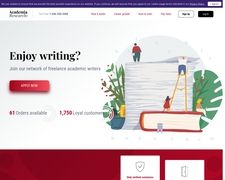 UnsolicitedAcademia Research has a rating of 3.4 stars from 35 reviews, indicating that most customers are generally satisfied with their purchases. Reviewers satisfied with Academia Research most frequently mention premium writer. Academia Research ranks 26th among Work At Home sites.  “Good Website for Writers”Even though it is a good site for developing writers, but, career development is not integrated in their levels. For instance, it is difficult to rise from the general level. I think the top 20 writers at any level should be promoted to enhance the writers' skills. A person in a managerial position from a supervisor guarantees that their leadership skills and activities would advance, that is what is needed in Academia-Reserch “My test assignment got declined listing errors that do not even exist in my paper.”My test assignment was declined on this website based on listing a number of errors that were not even present in my paper. I got the paper screened and verified through a number of experts and Grammarly premium. My paper's overall score of Grammarly was 99%. I have hereby attached the list of "errors" found by academia research in my paper. Reviews (35)Reviews that mention popular keywords I have been working for academia-research.com for few years now. I'm already a premium writer. There are certain issues like price per page and fining policy which may scare you at first. But the company's representatives can explain you why the price for one order differs from another one's. It all depends on the urgency, academic level, etc. They're also very tolerant if writer is late with an order delivery and will try to help
I worked with academia research.com on a number of projects mainly for students for whom English language is not mother tongue e.g., students from the African continent, Asia, Latin America etc. The work load used to be very regular and payment has always been timely.
Hello, I’m Alex and I’ve been employed with Academia-Research for half a year. Back then – the day I started here – I’ve got the minimal fee of $5 per page. But in 6 months (wow!) my wage increased up to $15. Today I can easily earn $500 a week without batting an eye. When I need the money, I assign to more orders and raise incomes twice as big. Working at home feels great. Financial wealth makes me happy and satisfied with what I do.
I have been working with many companies, seen different approaches towards writing business. I can tell you for sure that Academia research is one of the few companies which provide decent treatment for its writers. You really feel you’re employed in a respected firm with worldwide successes while it’s only an online job. For me as a premium writer it’s good money as well. The one who works hard gets it all
This company rocks! They take any one's order and turn it around in almost no time with professional responses. The work is also often very upbeat. Most writers like their work and enjoy the freedom, responsibility, and pay. They will pretty much take any order too, which means the sky is the limit!. If you're a budding freelancer this is a great place to learn about tailoring an article to suit a client's needs. You can pick and choose what you want to write about, and there's always enough orders to keep you busy if you feel industrious. If you join writing teams or attract a client who wants to order directly from you, that's more money. Since a lot of the team orders are pretty strictly formatted, once you get the hang of it you can churn out a lot in very little time. You get paid through PayPal once your account goes over ten dollars. Communication is good and response from office staff is quick and thorough. So far I've been very pleased with my experience.
I always preferred a free-lance work to the office one. Being a free-lance writer involves a flexible schedule and you can assume responsibility without strict directions. You are your own boss here. As I understood it I started to search for a free-lance writing job. When I found academia research I was really pleased to become one of its writers as Ive heard a lot about the content quality of it. So I strongly recommend those who are still looking for a free-lance writing work to start working for academia-research.com. Do not worry about the salary. They always pay for written works in time; you can take it from me.
I started working for the company in 2011 and the experience was great at the time with more work flow, excellent human relations and high cost per page. Today, cost paid per page has significantly reduced and their new grading system for writers mean even the most experienced writers hardly find orders to work on. Attitude of the support and quality assurance team continues to get worse. And to make matters worse, they now falsely accuse writers of using AI to generate text just to fine them and deny paying them for job done. That is the bitter experience of academia-research today.
Out of all companies I worked for, Academia-Research is the best one so far. It is extremely loyal to their writers. The support team is prompt and polite in their communication, and the quality control team is always ready to help if you need assistance. What is more, work itself is very interesting and challenging. I can choose the subject and topic of the paper I want to write myself, so it's the best place to apply my knowledge and combine it with my academic writing skills. Finally, the most important thing is that in the two years I work here, not even once was the payment delayed. I recommend Academia-Research to everyone looking for a flexible and reliable job.
Ive been working for academia-research.com for year and a half and got a lot of bonuses. Besides I often received positive feedback from people for whom I wrote assignments. Jeddah C. Maybe the problem is in you? Maybe you did your work not in proper way? Tip for consumers: a lot of bonuses from academia-research.com 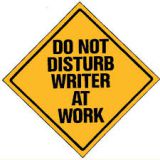
I finished the test essay and fulfilled all the requirements just for them to email me with "We are terribly sorry to inform that you have not met all the requirements and failed the test. Below are the reasons of test failure: Lack of academic writing skills; Structural errors; Poor content; Grammar and punctuation errors; Referencing/formatting drawbacks; Compromised identity You may try again in a year if you are interested in this opportunity. We appreciate your trying to cooperate with us." Keep in mind that I have been writing papers for two separate companies for years. I was just looking for a different company to start writing with. My last grade on an assignment was a 95% and it was on a much more complicated subject. Yeah... I'd trust my history of getting As by qualified professors over this ridiculous company.
A fascinating fact it is. I left the office position, that hideous suit and a boring white shirt, I see those insomniac faces no more, I get up when I want and work when I want and still I earn more than when I used to crouching back full-time. Now hold on! There is another even more fascinating fact. When I signed up with Academia, I knew little about composing fine academic content. All I had was a degree in Finances and a sheer determination to change my life. And now I'm here writing these lines. They pay me $10 per page as I really need to improve my self-editing skills. But when I do, I'll become a Premium writer with a wage as attractive as the job of a freelancer. That makes for a vigorous high five!
As an aspiring freelance writer, I'm delighted to share my positive experience with Academia-Research. Once registered, I was warmly welcomed by the company's Friendly team, who guided me through all the steps necessary to get started. Its powerful platform designed for writers definitely adds value. My ongoing Cooperation with Academia-Research promises to yield long-term gains as I grow Personally and professionally.
I am working with academia-research for the last eight years. I had written 480 essays and 81 customers appreciated my work as they scored high grades for their assignments. Further, I have helped many students to get their PHD degrees, Master degrees due to my quality essays and support services. Many of my customers have rated me with ***** five-star ratings which is the highest rating given by a satisfied customer to the writer. Some of the customers reviews are given below: · I would like to thank the writer for his way of writing and care to provide the best quality as well as his commitment to subject · Good work · Got a high mark for this coursework, thank you · Great job, very quick respond. I will request working with you next time. · Good service · Nice Mark I am proud to be the part of writers of academia-research
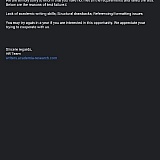 Hello! Quality is our main priority! Here you may check the detailed feedback: Lack of academic skills: • Non-academic sources (e.g., “StudyMoose. (2020, October 30). Hamlet Act 3 scene 1 Free Essay Example.”) • Misattributed quotes (e.g., “To Be or Not to be, this is the question.”(StudyMoose (2020)”) • Lack of proofreading (e.g., “…the betrayal he faced from Claudias,” instead of Claudius) Structural drawbacks • The paper should be about how does Shakespeare conveys the complexities of the human condition in Hamlet. But, unfortunately, the introduction does not mention either Shakespeare or Hamlet in any way. • Lack of a thesis statement • The conclusion does not connect back to the introduction and the essential question, "what are the complexities of being human?" Referencing/formatting issues: • Lack of a title page with the title of the paper and the author's name • No page numbering throughout • Improper in-text citations (e.g., “(February 2020) (Green (2017))”) • The reference list should begin on a new page separate from the text of the essay • All lines after the first line of each entry in the reference list should be indented one-half inch from the left margin. Best Regards, academia-research.com
I have been working for Academia-research approximately for half a year as a writer. I do not complain as I get cash for my texts timely and I also find this job really interesting and cognitive. There is always some work to do. So just stay cool, because academia-research.com service can give you something more than just cash and a place to work, it gives you experience, I think this is the most important thing for writers. So, if you are looking for writer job- try this service and you will never regret it.
I am having a wonderful experience of working with this website. I am a new writer, but I have already understood that the company is fair to the writers and sends the payment on time. I am happy that nowadays a freelance writer has an opportunity to develop his/her writing skills and undertake research while working from home. I strongly believe that I can built a good career with Academia and become an advanced writer.
Please dont have any deal with them. They are professional scamsters and cheaters. They exploit the writers or scholars who work for them. Often by cutting their hard earned pay: while overcharging the clients. Allegations against them are galore on web. Almost every writer who work with them have a bitter experience of either fraud or cheat.
I cant appreciate Academia -Research enough. I had joined the company in 2010 and i am still working and that makes me almost 6 years with them. When I joined i was less aware of academic writing but the company had given full support for my growth as a writer. I have faced many situations with the company and now i am an experienced writer and a steady income person. The best part of the company is the tolerance they have for their writers and their payment scheme. The company is honest and the best in the world at this point of time. I would encourage any one who has writing skill to work for Academia - Research. Now the company has become my identity as I have been with them for 6 years.
I have worked for them for almost a year part-time. They are very nice and understanding of all circumstances. I have grown as a writer and they supply many tutorials and tools to assist. I appreciate the extra income while I learn. Recommend them highly! Paulina
I wrote for them for around 14 years since 2008. You start off having to bid but as you progress and build your reputation with regular good work and become a premium writer, you can pick up orders on your own. It was a good time as a premium writer for some years until they made a change to their website which hid most orders. Eventually, the available orders trickled to so few that it became difficult to work for them. I suspect this was by design to prevent further progression. Importantly, they pay writers no more than around 35% of what they receive from clients, which is very low, and overall the experience has been that they care more to satisfy clients than they do for their writers. Many old writers must have left well before I did after they made communicating with clients more difficult, and especially when they began imposing heavy and often unjustified fines on us, which is far from treating writers as precious assets. To balance that however, there were occasional bonuses too. The final decision to leave came about when they limited their payment method options that made it no longer possible to receive money directly. Tip for consumers: The golden period is over and the pay is very low; nothing like what they claim average writers earn on their website. Perhaps still a good try for beginner writers though. They use several other front-sites to attract students who place the orders. Products used: We offered academic writing services.
This website does not really care for writers, they looooove their customers tho. They believe everything their customers say because even if their QAD would clear the quality of the paper but the customer still complains about the quality of the paper. The QAD would fine you big-time. You get a nice email from them that you are being fined, thats the extent of their communication with you. So be careful about working for them.
Academia-research.com is a scam and is composed of incompetetnt reviewers who have no understandiong of even basic mathematical functions and values. I maghine them declining my application that Incorrect calcualtions (π=3.1415...; not 3.1429). Ridiculous. Dont trust them with your essays. I tried contacting their support assistant Emma to tel them that their staff were wrong but she stubbornly insists that i am wrong. Please dont fall for this joke company. I attached the screenshot below. Youd rather save your money than request them to complete your assignments. My email *******@protonmail.com 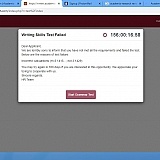
Communication-wise, this is the worst website I have ever seen. They take ages to reply to emails. Honestly, you need to up your game this 21st century.
I tried to register as a writer with them. There were some technical issues and I wasn't able to log in to my account. They did NOTHING to help me our or at least explain what could be the problem. Hello! We are here to help you! Kindly join us in the Live Chat or send your request to our email address [email protected]. Best Regards, academia-research.com Q&A (17)Hello, i am interested in working with you .. Am ready and competent, forecast with all the possibilities to work with u Hello, i would like to ask a question regarding to join your company. when i open your sign-up portion generate the error. how i can sign-up?Ami ai jobta. Korte parle onek khusi karon ai jobtai parbe amake Amer poribarer pase daranor Jonno sahajjo korte Hi i am a writer and money hasn't reflected from 20th august, what's the issue?Hello! We are deeply sorry for such a late response. If you have any payment issues, kindly contact our Support Team, and they will gladly help you. Best Regards, academia-reserach.com Where is academia-research headquartered? is academia-research affiliated with academic knowledge?The company is based in U. S and Academic Knowledge is another company. Which has no connection with Academia - Research. I want to join your compny as a writer but when i opnen the sign-up option the error may generate. can you help me how i can join your company.Hello is this academia-research.com, i am 66 years old and never wrote a blog or letter to editor. in my last job, i worked as a recruitment assistant for twenty years. i live in india. w, how can i join, how can i jion, how social stratification affects education in africa as compared to western world, can’t see your question ask to get answers from the academia research staff and other customers..
Sitejabber for BusinessGain trust and grow your business with customer reviews.  From the businessFreelance writer jobs for writers of all levels. Great opportunities for freelance writers looking for well-paid job. Work from home and earn money easily
Company Representative How do I know I can trust these reviews about Academia Research?
Need help finding something? Enter a search term below  IELTS Academic test - sample test questionsIelts academic is your key to studying where you want to go., jump to section.
Preparing for your IELTS Academic testWe want you to do well in your test. To help you get ready, here are some sample tests for the Academic test. Listening and Speaking tests are the same for IELTS Academic and IELTS General Training, but the Reading and Writing tests are different. With these official practice materials you can:
IELTS Academic - paper sample testsListening (30 minutes) . The Listening test is the same for both IELTS Academic and IELTS General Training and consists of four recorded monologues and conversations. The following IELTS Listening sample tasks are to be used with the Answer Sheet and MP3 audio files and/or transcripts. Each answer sheet indicates which recording to listen to, or if a transcript is provided. Listening sample tasks
Find out more about the Listening test Academic Reading (60 minutes)Texts for the Academic Reading test are taken from books, journals, magazines and newspapers. A variety of tasks is used, including: multiple-choice questions, identifying information, identifying writer’s views/claims, matching information, matching headings, matching features, matching sentence endings, sentence completion, summary completion, note completion, table completion, flow-chart completion, diagram label completion, short-answer questions. Academic Reading sample tasks
Find out more about the Academic Reading test Academic Writing (60 minutes)The Academic Writing test consists of two writing tasks of 150 words and 250 words. In Task 1, you are asked to describe some visual information (graph/table/chart/diagram). You need to write 150 words in about 20 minutes. In Task 2 you are presented with a point of view or argument or problem. You need to write your response in 250 words in about 40 minutes. Academic Writing sample tasks
Find out more about the Academic Writing test Speaking (11–14 minutes)In the Speaking test, you have a discussion with a certified examiner. It is interactive and as close to a real-life situation as a test can get. There are three parts to the test and each part fulfils a specific function in terms of interaction pattern, task input and test taker output. In Part 1, you answer questions about yourself and your family. In Part 2, you speak about a topic. In Part 3, you have a longer discussion on the topic. The Speaking test is the same for both IELTS Academic and IELTS General Training. Each of the three parts is designed to test a different aspect of your communication ability. Speaking sample tasks
Find out more about the Speaking test IELTS Academic - computer sample testsListening (30 minutes). The Listening question types for IELTS on computer are the same as in the IELTS on paper test. A variety of tasks is used including: multiple choice, matching, plan/map/diagram labelling, form completion, note completion, table completion, flow-chart completion, summary completion, sentence completion, short-answer questions. Listening Sample task Multiple Choice (one answer)You will hear an extract from a Part 3 recording in which a student called Judy is discussing her research with her tutor and fellow students. For each question, click on the correct answer.
You will hear an extract from a Part 1 recording in which two people are discussing a guide to a library. For each question, click on the correct answers.
Listening Sample task Plan/Map/Diagram Labelling (Type A)You will hear an extract from Part 2 of the test in which a tour guide describes different places in a US town. For each question, click on the correct space in the table.
Listening Sample task Note CompletionYou will hear an extract from a Part 1 recording in which two people are discussing second-hand furniture. For each question, write your answer in the gap.
Listening Sample task Table CompletionYou will hear an extract from a Part 4 recording in which a university lecturer is giving a talk about research into ‘learner persistence’.
Listening Sample task Flow-chart Completion (selecting from a list of words or phrases)You will read an extract from a Part 3 recording in which two biology students are comparing their research on evidence of life on Earth and other planets. For each question, click on the correct answer and move it into the gap.
Listening Sample task Sentence CompletionYou will hear an extract from a Part 3 recording in which two friends are discussing studying with the Open University.
You will hear an extract from Part 2 of the test in which a representative from a clothing company is giving a talk to high school students.
The Academic Reading question types in IELTS on computer are the same as in the IELTS on paper test. A variety of tasks is used including: multiple choice, identifying information (True/False/Not Given), identifying a writer’s views/claims (Yes/No/Not Given), matching information, matching headings, matching features, matching sentence endings, summary completion, note completion, table completion, flow-chart completion, diagram label completion, short-answer questions.
You will read an extract from a Part 1 text about older people in the workforce. Click on the correct answer.
Click on the correct answers.
You will read an extract from a Part 1 text about the scientist Marie Curie.
You will read an extract from a Part 1 text about dung beetles.
You will read an extract from a Part 1 text about the development of rockets.
Academic Reading Sample task Summary Completion (selecting words from the text)You will read an extract from a Part 3 text about the ‘Plain English’ movement, which promotes the use of clear English.
Academic Reading Sample task Summary Completion (selecting from a list of words or phrases)You will read an extract from a Part 3 text about language.
You will read a Part 2 text which discusses whether birds evolved from dinosaurs.
You will read an extract from a Part 3 text about the scientific community in London in the 1700s.
Academic Writing (60 minutes)The Academic Writing question types in IELTS on computer are the same as in the IELTS on paper test. In Part 1, you are presented with a graph, table, chart or diagram and are asked to describe, summarise or explain the information in your own words. You may be asked to describe and explain data, describe the stages of a process, how something works or describe an object or event. In Part 2, you are asked to write an essay in response to a point of view, argument or problem. Academic Writing Sample tasks
IELTS on computer practice experienceThe practice experience will show you how everything will look on your computer ahead of the test day. As these are practice tests, they are not timed. There are some variations from the live tests, including the timer, highlighting, and notes functions performing differently. In this Listening test sample , you will hear four different recordings. You will hear each recording ONCE only. The test is in four parts, with 40 questions in total. This Academic Reading sample will show you three texts to read. The test is in three parts, with 40 questions in total. This Academic Writing sample consists of two writing tasks.  Where can you go?See where an IELTS result could take you.  Book your testReady? Book your IELTS test now.  Our tips for a great experience.
2024. IELTS is jointly owned by the British Council; IDP IELTS; and Cambridge University Press & Assessment Remove Product?Are you sure. 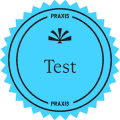 Core Academic Skills For Educators: Writing (5723) Prepare Before Taking This Test!Level up your knowledge and your chances to pass the test. Boost your confidence for the Core Academic Skills for Educators: Writing (5723) test. Take a full-length, interactive practice test with 42 questions covering all the topics on the test, such as text types, purposes, and production, and more. Boost your confidence for the Core Academic Skills for Educators Writing (5723) test. Take a full-length, interactive practice test with 42 questions covering all the topics on the test, such as text types, purposes, and production, and more. About The TestThe Core Academic Skills for Educators Test in Writing measures academic skills in writing needed to prepare successfully for a career in education. All skills assessed have been identified as needed for college and career readiness, in alignment with the Common Core State Standards for Writing. Study.com Free Praxis Core Prep - Build the skills needed for success on the Praxis Core exam.  Related Content Included With This TestLocation Facilities Select between online (at home) or at Test Center Easy Scheduling Schedule the day & time of your preference Score Recipients Get three score recipients for your test results to be send Free Test Prep Get one of the available Test Preparation options for free Prepare With Official Praxis Test Prep Packages
Comprehensive State RequirementsSee what tests your state requires for licensure. Strategies & TipsFind information to help you effectively prepare for test day. Videos & WebinarsSee what to expect on the day of your test and how to navigate a Praxis test. Information BulletinReview the Praxis Test at a glance, Registration information and what to expect during test day. DescriptionAcademia.edu no longer supports Internet Explorer. To browse Academia.edu and the wider internet faster and more securely, please take a few seconds to upgrade your browser . Enter the email address you signed up with and we'll email you a reset link.
 Examining Social Studies Course Questions in Terms of Question Type and Test Item Writing Techniques 2023, Türk akademik yayınlar dergisi (tay journal) Loading Preview Sorry, preview is currently unavailable. You can download the paper by clicking the button above.
TERMS AND CONDITIONSThank You for visiting Academia-Research.com(“ Website “)! Please read these Terms and Conditions (“ Terms ” and/or “ Terms and Conditions “) carefully before submitting your registration form to participate in the Academia-Research.com’s Freelance Writing Program (“ Program ”), because by using this Website You agree to abide by these Terms and Conditions. Your use of the Website and entering into the Program are governed by the following Terms as applicable to the Website. These Terms are applied to all Writers (as this term defined hereunder), visitors, users and others who access and/or use this Website. If You transact on and/or use the Website, You shall be subject to this Terms. By using the Website, You agree that these Terms and Conditions constitute your binding obligations. ACCESSING, BROWSING OR OTHERWISE USING THE WEBSITE INDICATES YOUR AGREEMENT TO ALL THE TERMS AND CONDITIONS, SO IF YOU DISAGREE WITH THESE TERMS OR ANY PART OF IT THEN YOU MUST NOT USE THIS WEBSITE. Definitions “ Writer ” and/or “ You ” mean the business, individual, entity, applicant, or end user accessing the Website, its contents, submitting the registration form, and participating in the Program, offered through the Website. “ Writer Fee ” means your fee (Writer Total) for each purchase of Services by a Customer under and in accordance with these Terms. “ Customer ” means a customer who uses and/or consumes the Services . “ Registration Form ” means any and all order forms, registration forms, or other signup or acceptance forms (whether online, paper, fax, or otherwise), including any information in it, provided by You. “ Services ” means academic writing services that Customer purchases through the Service Providers. “ Service Provider ” means Academia-Research.com and/or Academia-Research.com related parties and/or Academia-Research.com partners. “ Paper “/ “ Work ”/ “ Order ” shall mean an original written academic writing work that is drafted by You in accordance with these Terms and Conditions, including, but not limited to, essay, term paper, research paper, dissertation review, book report, and/or other type of assignment written by You. “ We “, “ Our ”, “ Us ” and/or “ Ourselves ” mean Academia-Research.com Any use of the above terminology or other words in the singular, plural, capitalization and/or he/she or they, are taken as interchangeable and therefore as referring to same. Eligibility By participating in Program You (Writer) represent(s) and warrant(s) that
By participating in Program You agree that We reserve the right to delete your Writer’s Profile or terminate your cooperation with Academia-Research.com without warning, if We believe that information You provided to Us does not conform with the Terms` eligibility requirements and/or You do not fit the representations and warranties set forth in these Terms. Enrollment in the Program Your Writer`s Profile gives You access to the Program and functionality of the Website that We may establish and maintain from time to time and in our sole discretion. You are responsible for any and all occurring activities and/or downloaded Paper under your Writer`s Profile. To begin the enrollment process, You must complete a Registration Form. The Registration Form can be found at: Academia-Research.com Upon completion of Academia-Research.com registration process, You will receive a password and a profile (“ Writer`s Profile ”) designation. You are fully responsible for maintaining the confidentiality of the password and Writer`s Profile. You are fully responsible for all activities that occur under your password and/or your Writer`s Profile. You agree to (i) notify Us immediately about any unauthorized use of your password and/or Writer`s Profile or any other breach of security. (ii) You must ensure You exit from your Writer`s Profile at the end of each session. We will not be liable for any loss and/or damage arising from your failure to comply with these provisions. To qualify as a Writer, You must also 1. pass our grammar test and 2. write a test essay that will be examined by our Quality Assurance Department within five (5) day term. If your grammar test or test essay is denied, You may apply again for Writer qualification in six (6) months. By giving Us your email address, You grant us permission to send You communications from Academia-Research.com, such as Writer`s Profile creation confirmations, service announcements, administrative messages, and any of the opt-in Academia-Research.com newsletters. You may opt out of certain email communications from Academia-Research.com by following the instructions on your Writer`s Profile. You may not opt out of Program-related messages. If You do not want to receive Program-related messages from Academia-Research.com, You must terminate your cooperation with Academia-Research.com and cancel your Writer`s Profile. Verification. In order to verify electronically your identity, We will ask You to provide your personal details (such as your name, address, date of birth, email, telephone number) and details of your identification documents as specified in our Privacy Policy. You authorize Academia-Research.com directly or through third parties to make any inquiries, it is considered necessary to validate your Writer`s Profile and/or any other information, including financial, You provide Us while registration process. Essentially, the procedure involves, inter alia, validating your identity and confirming that information You have provided is truthful and accurate. Please note that We use your phone number and/or your email to contact You and to verify your identity. Therefore, it is vital to provide Us with your accurate and valid phone numbers and email. You are responsible for informing Academia-Research.com about changes to your postal address, e-mail address, and phone numbers, as well as about any other changes to your name, phone number, contact information, payment information, or other personal information that will impact Academia-Research.com’s ability to verify your identity and to issue a valid Writer`s Fee payment. Any information about changes in your personal details must be submitted at least fifteen (15) business days prior to the end of the calendar month in order to issue Writer`s Fee for that month. Please note that You are required to pass additional verification procedure in case You change phone number and/or email address. You may not take/ receive any Order, until our Risk Department verifies You/ your new phone number and/or email address. If the verification procedure fails and you do not provide Us with the correct phone number and/or email address within fourteen (14) calendar days, your Writer`s Profile shall be deleted and your cooperation with Academia-Research.com shall be terminated. By agreeing to these Terms and Conditions You also agree to the following: 1. the information You provide is your personal information and 2. You have authority to provide it to Us, and 3. We may use and disclose your personal information for the purposes of electronic verification as described above and in accordance with our Privacy Policy. Further information about how we collect and handle personal information is available in our Privacy Policy. Paper, Paper Instructions and Materials. Subject to full compliance with the Terms, You/Writer undertake(s) to provide Academia-Research.com with Paper in accordance with the Customer`s instructions. Your Paper must meet Customer`s confirmed instructions. Customer cannot change the initial instructions after the instructions have been confirmed. Any alterations to confirmed instructions are considered as additional instructions that should be paid additionally. You must provide the Papers of the standard format (except as otherwise specified by the customer):
The standard Paper format includes a Title page, Outline page or Abstract (if needed), Body of the Paper and Reference page. Note that You are paid only for the main content of the Paper. Unless the Customer indicates some specific sources to be used, You have the right to use any relevant materials available: books, journals, newspapers, interviews, online publications, and others. If Customer specifies that certain sources/ material are required or are essential to the completion of the Paper: 1. You find one in your order instructions; 2. Customer provides them to You via Internet; or 3. Customer buys such sources/ material and provide it to You or reimburses your costs/ expenses incurred. Please note that You are not responsible for any delays caused due to nonreceipt of the Customer`s specific sources/ materials. Restrictions and Prohibitions In your use of the Program and this Website, You must abide by the following restrictions and prohibitions. As a Writer, You may not:
Payments and Payment Mechanisms Our obligation to make a Writer Fee payment is subject to the condition precedent, including, without limitation:
Academia-Research.com reserves the right to suspend payment of Writer Fee(s) at any time and for an indefinite term, if it suspects fraud or other improper activity and/or a potential breach by the Writer of any of the provisions of these Terms and Conditions. Academia-Research.com, in its sole discretion, reserves the right to reduce, and/or to withhold indefinitely, and/or to reverse, and/or to deny, and/or to reject any Writer Fee, in following cases:
The payment method shall be chosen by Academia-Research.com according to the Writer’s location, availability, and convenience of certain payment method. Academia-Research.com in its sole discretion may grant the Writer a right to choose the payment method that Academia-Research.com will use for processing of all payments to Writer. All payments shall be processed via worldwide online payments systems (including, but not limited to Payoneer, E-payments, Revolut) and/or via wire transfer. If the Writer wants to change his/her payment method and/or alter any payment information, he/she will have to pass the verification procedure and provide us with the official documents for security purposes. Writers’ salaries for completed works are paid twice per month, i.e. on the 10th and 25th (“ Payment Date ”). Works which are successfully completed between the 15th and 30th (31st) of the previous month are paid on the 10th of the current month. Works which are successfully completed between the 1st to the 15th of the current month are paid on the 25th of that current month. Academia-Research.com reserves a right to change the Payment Dates because of sudden/unexpected circumstances/ technical difficulties. In case of sudden/unexpected circumstances/ technical difficulties, Writers will be notified via Writer`s Profile and/or via emails. Please note that your participation in the Program may be suspended or approval withheld until Academia-Research.com can validate that You have a valid Writer`s Profile with approved payment method. By participating in the Program, You assume sole responsibility for any taxes owed, and You agree to pay all applicable taxes and/or charges imposed by any government entity in connection with your participation in the Program. Academia-Research.com reserves a right to apply the following fines and measures, depending on the particular reasons, circumstances, and the amounts refunded back to the Customer:
Should the Paper fail to meet Customer`s instructions, Writer is obliged to provide free of charge Paper revision. Any Customer`s revision request or complaint in regards to a Paper shall be made within the revision period (“ Revision Period ”). Academia-Research.com offers a 14-day Free Revision Period for Papers less than 20 pages, and a 30-day free revision period for Papers more than 20 pages. Free Revision Period begins on the date of Order deadline and expires on the last day of the Free Revision Period. Customer is entitled to request as many revisions as may be required to make the Paper consistent and compliant with Customer`s instructions. During the Free Revision Period the request for revision may be made at any time. Limitations of liability Academia-Research.com SHALL NOT BE LIABLE TO YOU OR TO ANY OTHER PERSON OR ENTITY FOR ANY INDIRECT, CONSEQUENTIAL, INCIDENTAL, SPECIAL, OR EXEMPLARY DAMAGES, INCLUDING LOST PROFITS, ARISING OUT OF OR IN CONNECTION WITH THIS TERMS AND CONDITIONS. Academia-Research.com’s TOTAL LIABILITY TO A WRITER OUT OF OR IN CONNECTION WITH THIS TERMS AND CONDITIONS IS LIMITED TO THE GREATER OF FIVE HUNDRED DOLLARS ($500). Confidentiality We are committed to protecting your confidentiality. Authorized employees on a need to know basis only use any information collected from Writers. Writers` records are regarded as confidential and therefore will not be divulged to any third party, but only if it is required by the legal authorities. We will not sell, share, or rent your personal information to any third party, or use your e-mail address for unsolicited mail. Confidential information does not include information that:
Any feedback/ testimonial You provide to this Website shall be deemed to be non-confidential. We shall be free to use such information on an unrestricted basis. Furthermore, by submitting the feedback/ testimonial, You represent and warrant that (i) Your feedback/ testimonial does not contain confidential or proprietary information of You or of third parties; (ii) we are not under any obligation of confidentiality, express or implied, with respect to the feedback/ testimonial; (iii) and (iv) You are not entitled to any compensation or reimbursement of any kind for the feedback/ testimonial under any circumstances. By agreeing to be legally bound by these Terms and Conditions Writer hereby perpetually, irrevocably, and unconditionally assigns, transfers, and conveys to Academia-Research.com and its successors and assigns, all of Writer’s right, title, and interest in and to the all intellectual property (“ Intellectual Property ”) and intellectual property rights ( “Intellectual Property Rights ”) forming a part of, embodied, in or necessary for use of the Paper. Writer further perpetually, irrevocably, and unconditionally assigns, transfers, and conveys to Academia-Research.com and its successors and assigns all claims for past, present and future infringement or misappropriation of the Intellectual Property Rights included in the assigned Paper, including all rights to sue for and to receive and recover all profits and damages accruing from an infringement misappropriation prior to the effective date of assignment as well as the right to grant releases for past infringements. Transfer of Intellectual Property and Intellectual Property Rights by the Writer to the Academia-Research.com shall be deemed to come into effect, and the Academia-Research.com shall be deemed to have become the owner of the Intellectual Property and Intellectual Property Rights on the date of Paper is downloaded. Writer hereby represents and warrants to Academia-Research.com that: Writer exclusively owns all right, title, and interest in and to the assigned Intellectual Property and Intellectual Property Rights; Writer has not granted and will not grant any licenses or other rights to the Intellectual Property and Intellectual Property Rights to any third party; the Intellectual Property and Intellectual Property Rights are free of any liens, encumbrances, security interests, and restrictions on transfer; to Writer’s knowledge, the Intellectual Property and Intellectual Property Rights that is assigned do not infringe Intellectual Property Rights of any third party; and there are no legal actions, investigations, claims, or proceedings pending or threatened relating to the Intellectual Property and Intellectual Property Rights. These Terms and Conditions shall remain in effect and binding for You for as long as You continue to participate in the Program (“Term”). Either of us may terminate these Terms at any time, with or without cause, by giving the other party notice of such termination. No Writer`s Fee shall accrue or be earned by You after the Term. Writer is only eligible to earn Writer`s Fee occurring during the Term, and fees earned through the date of termination will remain payable only if the related Orders are not canceled or returned. The “Confidentiality” and “Copyright” obligations set forth herein shall survive the termination of these Terms and Conditions for any reason whatsoever. . Disclaimer THE PROGRAM IS PROVIDED “AS IS”, “AS AVAILABLE”, WITH “ALL FAULTS”, AND ALL WARRANTIES, EXPRESS OR IMPLIED, ARE HEREBY DISCLAIMED, INCLUDING, BUT NOT LIMITED TO THE IMPLIED WARRANTIES OF MERCHANTABILITY, FITNESS FOR A PARTICULAR PURPOSE AND NON-INFRINGEMENT. YOU EXPRESSLY UNDERSTAND AND AGREE THAT YOUR PARTICIPATING IN THE PROGRAM IS AT YOUR SOLE RISK. THE PROGRAM MAY CONTAIN BUGS, ERRORS, PROBLEMS OR OTHER LIMITATIONS. Academia-Research.com MAKES NO WARRANTY THAT THE PROGRAM WILL BE UNINTERRUPTED, TIMELY, SECURE, OR ERROR-FREE, OR THAT THE QUALITY OF ANY SERVICES, INFORMATION, OR OTHER MATERIAL OBTAINED BY YOU THROUGH THE PROGRAM WILL MEET YOUR EXPECTATIONS. ANY CONTENT DOWNLOADED OR OTHERWISE OBTAINED THROUGH THE USE OF THE WEBSITE IS DOWNLOADED AT YOUR OWN RISK AND YOU WILL BE SOLELY RESPONSIBLE FOR ANY DAMAGE TO YOUR COMPUTER SYSTEM OR LOSS OF DATA THAT RESULTS FROM SUCH DOWNLOAD OR YOUR USE OF THE PROGRAM AND THIS WEBSITE. Notification of Changes We expressly reserve the right to change these Terms and Conditions from time to time without notice to You. You acknowledge and agree that it is Your responsibility to review this Website and these Terms and Conditions from time to time and to familiarize yourself with any modifications. Your continued use of the Website after such modifications will constitute acknowledgement of the modified Terms and Conditions and agreement to abide and be bound by the modified Terms and Conditions. Academia-Research is an online academic writing and consulting company. Since 2004, we have worked to ensure the highest quality standards of service and offer a stable income for aspiring academic writers. We value our employees, ensure career growth, provide various rewards programs, and 24/7 support. Register now. Writing test. After the first test, the system will be ready to generate the topic in accordance with one of your major subjects upon the click of a button. The link to pass the writing test will be available for 3 days; be sure to start it by then. Write around 200-250 words on the given topic. The deadline is 60 minutes. Academia Research offers you decent pay rates and career growth opportunities in the academic writing field. The registration process requires a test to get selected. With the array of AI tools we've explored today - from research and mapping, literature review, peer-reviewed papers reading, scientific writing, to academic editing and grant writing - the landscape of research is significantly transformed. A good research question is essential to guide your research paper, dissertation, or thesis. All research questions should be: Focused on a single problem or issue. Researchable using primary and/or secondary sources. Feasible to answer within the timeframe and practical constraints. Specific enough to answer thoroughly. Like the prerequisite course, this unit focuses on putting your research to work to strengthen your academic writing. We will study how to use the results of your research and analysis to bolster written arguments and support rhetorical strategies. Unit 5 focuses on how to use style standards and citation methodology correctly. Learn the basics of research writing with Quizlet flashcards. Test your knowledge of evidence, unity, topic sentence and more. Have you got any questions as for freelance writing jobs? We at Academia-Research.com are absolutely open regarding our policies and therefore strive to answer all frequently asked questions here. In this guide we concisely explain how to write an academic research paper step by step. We'll cover areas like how to start a research paper, how to write a research paper outline, how to use citations and evidence, and how to write a conclusion for a research paper. This introductory program was created by JSTOR to help you get familiar with basic research concepts needed for success in school. The course contains three modules, each made up of three short lessons and three sets of practice quizzes. The topics covered are subjects that will help you prepare for college-level research. Each module ends with an assessment to test your knowledge. How to Do Academic Research. Few high school students or college underclassmen are prepared to conduct the type of academic research their instructors expect. While many institutions offer library orientation sessions, the information is rarely at hand when students are dealing with midterm or finals panic. Furthermore, those sessions generally ... The title of this book is The Process of Research Writing, and in the nutshell, that is what the book is about. A lot of times, instructors and students tend to separate "thinking," "researching," and "writing" into different categories that aren't necessarily very well connected. First you think, then you research, and then you write. Writing academic papers for desperate students isn't my thing, but I was recommended this site for their proofreading work, which they claim you can only access by becoming one of their writers. This includes taking a 'test' where you basically write a research paper, using whatever topic they designate, within 3 days. 35 reviews for Academia Research, 3.4 stars: 'I have been working for academia-research.com for few years now. I'm already a premium writer. There are certain issues like price per page and fining policy which may scare you at first. But the company's representatives can explain you why the price for one order differs from another one's. It all depends on the urgency, academic level, etc. They ... Academic Writing test. In this Listening test sample , you will hear four different recordings. You will hear each recording ONCE only. The test is in four parts, with 40 questions in total. Over 11,000 institutions around the world accept IELTS. This includes thousands of universities, colleges or academic institutions who trust IELTS to…. Best Academic Writing Jobs for Real Writers If you want to help students with their homework and written assignments, we at Academia-Research have an opening for an academic freelance writer! We offer a wide range of tasks: from all kinds of short compositions to research papers and all kinds of academic long reads. Our team of freelancers entails only skilled and knowledgeable experts in more ... The CUNY Assessment Test in Writing (CATW) is a standardized writing test that measures D VWXGHQW·V DELOLW\ WR GR FROOHJH-level writing in English. Entering first-year students take the test to determine their placement into English composition, ESL, or developmental writing courses. In addition, the CATW is used to determine when students are ready to exit from developmental writing courses ... Free online IELTS Academic Writing practice tests - paper You will be allowed 1 hour to complete two tasks in the IELTS Academic Writing test. Noteworthy outcomes showed that the overall level of the respondent's writing skills based on the self-assessment of English Writing Skills in terms of content, organization, language use, vocabulary and mechanics was very good. Additionally, the overall structure of the respondent's research output was good. Get Essay Writing Jobs at Academia-Research.com Are you a subject matter expert in your field and want to get paid for writing essays for students? Academia-Research is a great way for talented writers to connect with hundreds of students that need high-quality academic content for a wide range of topics. Below you will find example writing answers for all the writing questions in the ieltshelpnow.com Academic Practice Tests, tests 1 to 5. All of these example reports and essays were written by an IELTS examiner in order to give examples of good Academia.edu is a platform for academics to share research papers. Examining Social Studies Course Questions in Terms of Question Type and Test Item Writing Techniques ... Study data were collected from 20 social studies teachers and analyzed through the "Item Writing Techniques Checklist". Research findings revealed that social studies ... TERMS AND CONDITIONS Thank You for visiting Academia-Research.com("Website")! Please read these Terms and Conditions ("Terms" and/or "Terms and Conditions") carefully before submitting your registration form to participate in the Academia-Research.com's Freelance Writing Program ("Program"), because by using this Website You agree to abide by these Terms and Conditions. Introduction Your use ...
Camper & Nicholsons Yachts presenting SAGITTA 45 superyacht tender at FLIBS 2014
Related NewsPopular news this week, popular news this month, latest news.
Written by Zuzana Bednarova The legendary yacht brand, Camper & Nicholsons Yachts , is currently attending the prominent Fort Lauderdale International Boat Show (FLIBS). The company is on hand on the Hall of Fame dock (slips 48 & 49). In addition to the Endeavour 42 as well as Velsheda 50, which are being showcased, the all-new ground-breaking walk-around Sagitta 45 superyacht tender – is also being presented at the event.  Sagitta 45 - Sport Diving The Sagitta 45 yacht tender is the new sport cruiser by Camper & Nicholsons Yachts, designed for those who enjoy the sea for both sport and leisure. Uncompromised in the trademark elegance and sophistication associated with C&N Yachts, the Sagitta 45 is a true chameleon. It can be adapted to a variety of uses and can change radically with minimum effort. The design is meticulous and no detail is overlooked. Custom elements throughout the boat ensure timeless beauty. As in every C&N Yacht, the priority is seaworthiness. The deep V hull, penned by the legendary Raymond C. Hunt design team, is a guarantee of performance. It excels in rough seas, with a gentle yet firm passage over the waves that allows the yacht to navigate effortlessly without needing to reduce speed. C&N utilizes the latest technology available: vacuum infusion with closed cell foam sandwich for hull and deck, reinforced bottom with structural elements. This technique allows the weight to be concentrated in the lowest point, reducing pitch and roll. Moreover, the use of vinyl resin for the lamination ensures better protection over time against osmosis. 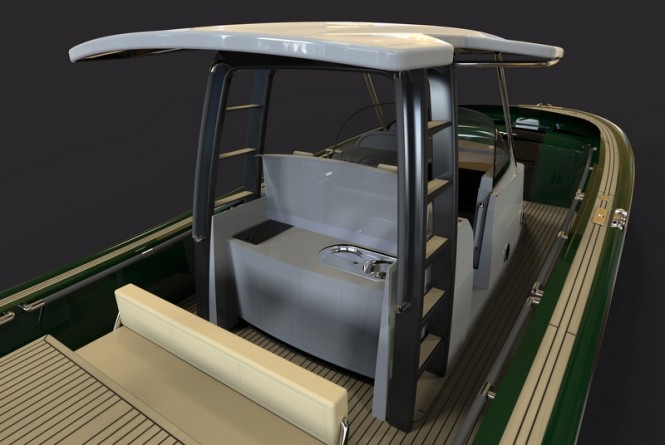 Sagitta 45 - Sport Cruiser Conceived as a typical ‘walk around’, the deck areas are dedicated to al fresco living. Towards the bow, there is a protected sunbathing area dedicated windscreen and a sunpad that is recessed into the coachroof. Aft of the sunpad, at the helm there is a double seat and a large electronics panel with the option for more electronics in a second panel on the underside of the hard top. Then behind the double seat is a fully equipped galley. From the galley, aft to the transom, the space is completely customizable. The Sagitta 45 luxury yacht tender will adapt to your favourite activities. There are specific modules for each function: if you cruise with friends and family during the summer the Sport Cruiser layout will provide you with a complete dinette and a large second sunpad with a folding backrest that will extend its length. The Sport Fisherman is fully kitted out and for those who prefer diving, the Sport Diving layout provides a dedicated area for guests and dive equipment. The modern and sophisticated design of the aft cockpit provides direct, but sheltered access to the large swim platform that is an integral part of the boat. On the bow, the forward deck above the cabin is completely free from obstacles. The area is dedicated to another sunpad, whilst the anchor disappears electrically with only the beautiful, rounded steel bow remaining in view: one of the many custom details that distinguish the Sagitta 45.  Sagitta 45 - Sport Fisherman The interior layout features two separate areas, to guarantee the owners’ maximum privacy. Forward is dedicated to a master suite with large double bed, head with separate shower and a complete wardrobe. The suite has plenty of natural ventilation and air conditioning to provide a restful atmosphere. The second area, under the coachroof of the helm, offers a customisable space: galley with optional second refrigerator, stowage of equipment or crew quarters with a head. Furthermore, the interior furnishings onboard the Sagitta 45 are rich in elaborate handmade details. The design is a mix of British tradition and Italian style, with precious materials and finishes and the ample use of solid wood panelling. The Sagitta 45 megayacht tender is a bespoke day cruiser, where the day may never end. Technical specification of Sagitta 45 yacht tender: Length overall 13.96 m 45’10” Beam max 3.80 m 12’6” Draft 0.96 m 3’2” Fuel tank 1,450 l 383 gal Water tank 300 l 80 gal Displacement 11.9 t 26,235 lb Maximum speed 36 knots Engines 2 x Volvo Penta IPS 500 370hp @ 3500 RPM Concept & design Camper & Nicholsons Yachts Naval architect Raymond Hunt Design Please contact CharterWorld - the luxury yacht charter specialist - for more on superyacht news item "Camper & Nicholsons Yachts presenting SAGITTA 45 superyacht tender at FLIBS 2014".
Quick EnquirySuperyacht news:. Email Your Yachting News to: news @ charterworld.com  Camper & Nicholsons Fort Lauderdale US debut of Wider 32’ superyacht tender at FLIBS 2014 Wider 32′ superyacht tender to debut at Fort Lauderdale Int’l Boat Show 2014 Selection of superyachts over 80ft to be displayed at 2014 Ft. Lauderdale International Boat Show Luxury superyachts by Moonen to be displayed at FLIBS 2014 Latest Amels superyacht AMELS 6006 completes her first sea trials Motor yacht GALILEO in the Maldives until October 9th offering 10% off remaining weeks 2024 MONACO YACHT SHOW: Only two weeks to go before the superyachts dock at Port Hercule Charter special offer on board 43m luxury yacht SUNRISE Yacht Charter Etiquette: Essential advise for a seamless travel experience Luxury motor yacht SIDURI III for charter in the Western Mediterranean 10 sensational superyachts with spectacular swimming pools A luxury charter yacht is the perfect way to encounter New England’s fall foliage display 45m custom superyacht SAN will debut at the 2024 Monaco Yacht Show 31m luxury yacht CARPE DIEM available for charter in the Bahamas Inaugural CROYA Charter Show announced for 4th to 6th October 2024 in Split, Croatia Charter yachts offering citizen science opportunities around the world 55m superyacht YN20555 is launched by Heesen Yachts and named superyacht SERENA Late summer special offer on board 72m superyacht ARBEMA in the Western MediterraneanYou are using an outdated browser. Please upgrade your browser or activate Google Chrome Frame to improve your experience.
SAGITTA Yacht for Sale Sagitta Yacht for Sale - 45' Fountaine Pajot Open Gallery  Contact Us For More InformationDetailed information. Content Sections DescriptionSagitta is an exceptional example of the very popular Fountaine Pajot Elba 45 catamaran.She features the desirable 3-cabin Owners Version layout and an extensive list of options and upgrades.Sagitta is in immaculate condition and shows like a brand new boat.Having recently (Dec 2023) completed her annual haul out period including saildrives service, rudder replacement (FP Warranty recall), and new bottom paint. Sagitta is ready to continue cruising immediately. The Elba is known for having a bright, spacious interior with an ergonomic, functional layout . It boasts energetic lines and inverted bows, accommodating incredible interior living spaces and giving her excellent sailing performance compared to other catamarans in her category.This elegant catamaran also has a wonderfully designed helm station to allow for ease of handling and the ability to control everything from the helm.She is ideal for a cruising couple or short-handed sailor. Highlights include: -900ah ReLion 12V Lithium House Battery Bank - Volvo 60hp Engines (Only 450hrs!) -11kW Onan Generator -56,000 BTU Air Conditioning throughout -Washer / Dryer -Electric Dinghy Lift Platform / Swim Deck -Schenker Watermaker 16 G/h -3 x 365w Sunpower Solar panels (1100w total) Sagitta is available for showings by appointment in beautiful St Augustine, FL.
MEASUREMENTS
Accommodations
Specifications Accommodations: Sagitta has a Maestro 3-cabin layout with the factory Oceanic Package.The port side Owner’s Hull features a Queen berth aft, desk at mid-ship, private head, and a vanity and large separate shower at the bo are two guest cabins on the starboard side with two heads and separate shower stalls.The salon is bright and spacious with a u-shaped settee and coffee table.The galley has ample counter space and storage. Beige/Gris PVC outdoor upholstery Foam Mattress Toppers on all bunks Curtains in cabins Interior / exterior Sunshades for salon Fresh water Electric Heads Interior 12V outlet and waterproof exterior 12V outlet LED Interior Courtesy Lighting 2 x Electric freshwater pumps Slatted bases for all beds Custom foam mattress in owners cabin 3 xCaframo Sirocco Cabin Fans – 12v Carbon Monoxide detectors Holding tank monitors 3 Burner Gas Stove Built-in Eno Gas Grill in Cockpit US propane LPG installation Isotherm 190L Double Drawer Fridge – 12v Isotherm 90L Freezer – 12v Vitrifrigo Drink fridge in Cockpit Galanz Microwave / Air Fryer / Convection Oven Countertop Icemaker Double basin SS Sink Pressurized hot and cold freshwater from mixer faucet Pressurized seawater system with faucet at sink Draining dish rack Bimini with Full Helm Enclosure Electric Dinghy Lift Platform / Swim Deck with remote control Synthetic Flexiteak floor on transoms and cockpit Ultra 35kg Anchor with Ultra Swivel and 200ft of 12MM G4 Chain plus 150′ Rode Quick Electrical Windlass (1500 Watts) w/ wired remote in anchor locker Additional Windlass Control and Chain Counter at helm Upgraded Anchor Bridle – added thimbles and shackles 2 bow seats Deck shower with hot / cold water mixer Dralon protective cover for wheel Helm Wheel Lock Cockpit courtesy lighting Outdoor cushions (cockpit + upper lounge deck + foredeck seating) Detachable Hanging Sun Awning for the foredeck Textelene net cover for trampoline Cockpit Sun Shades Lifeline netting Mooring lines + 6 fenders Additional Mooring Cleats Fresh water Washdown Interlocking PVC drainage tiles under seat cushions Bottom Paint – Mar Pro Super B Ablative (Nov 2023) Sails and Rigging: Incidence Dacron Mainsail – fully battened square top Incidence Dacron Genoa Incidence Gennaker on continuous furler Profurl Genoa furler 10mm Dyneema main halyard FP factory Bowsprit and all hardware to rig downwind sails 1 x Lewmar Electric Winch for mainsail halyard and mainsheet 3 x Lewmar Manual Winches Automatic mainsail Hook Line stoppers for Genoa sheets Quadruple clutch for reefs 1, 2 and 3 + toping lift Electronics: Garmin Full Navigation Package (New in 2023) 2 x 10in Multifunction Chart Plotter displays (at helm and in salon) 2 x Garmin GMI 20 Displays at helm Garmin Autopilot Garmin VHF with masthead antenna Garmin Radar + support + wiring Second Standard Horizon VHF / AIS at helm station Garmin Panoptix Live Scope Forward Sonar Aft facing Camera for Garmin plotter Fusion Stereo (New 2023) – Bluetooth w/ Bose Interior speakers and Polk exterior bow speakers Flat Screen TV on swivel mount in the saloon Digital TV antenna Starlink High Speed Internet Iridium GO mounted w/ outdoor aviation antenna Rouge Wave WiFi AMp W/Wifi Router Systems and Electrical: 110v / 60 Hz House Circuit 3 x300ahRelion LithiumRB300 HouseBatteries (900ah total) Victron3000 Watt Invertor/Charger (New 2023)) 11kW Onan Generator – 110V / 60hz – 1260hrs 3 x 365W Sunpower X22 Solar panels on Stainless Arch 3 x Victron MPPT Solar Controllers 2 x 115amp Balmar High Output Alternators Sterling B2b Chargers 110V Water heater Schenker Watermaker 16 G/h (60L/h) 12V 56,000 BTU Air conditioning 110V 60HZ with upgraded raw water strainers Splendide Washer / Vented Dryer Galvanic Isolator 110v protection 110v Outlets throughout the boat and in each head 4 x Underwater Lights – Macris Flat style – single color Mechanical: 2 x 60HP Volvo Penta D2-60 – Factory Upgrade – 450hrs each Volvo Saildrives 3-blade Folding Props with Line Cutters Oil pressure and Water Temp senders on both engines gauges at helm Engine Interface to Plotters FireBoy – Engine room fire suppression systems (Certified Nov 2023) Safety and Extras: OC 330 Tender 10.8ft carbon fiber tender with 20hp Tohastu Outboard Custom dinghy cover Life Raft Plastimo Transocean ISO 9650 Canister +24h – 6 person Extensive inventory of spares Fire Extinguishers (Certified Nov 2023) Fire Blanket Carbon Monoxide Detectors Sign up and GET 20% OFF Your first boat rental Welcome to Sailo ! Your code is: Enjoy 20% off
Departure dateTrip duration, multiple days (less than 1 week), weekly trip show boats that have weekly prices. most weekly boats outside of the us are available only saturday to saturday., boat length: 5ft -, manufacturer, boat build year: -, weekly trip, price: $ - $, no boats found, to see more results try changing your dates, moving the map, or removing your filters, renting a yacht is the best way to discover moscow, russia, learn how to find the right boat for great yachting experiences, how much does it cost to rent a moscow, russia boat for a day, will i be charged a security deposit for my sailo charter, because we love the ocean.
Motor Boat Charters Moscow. Motor Yacht Charter MoscowTop-rated yacht charters in moscow - preselected yacht rentals:.  Yacht Elegance 64 for rent in Khimki Marina
Using this site requires JavaScript. You are either using a browser that does not support JavaScript or has JavaScript disabled. Please click here for detailed information. Please use a modern browser to view this website. Some elements might not work as expected when using Internet Explorer.
SAGITTA Yacht Charter Brochure36.6m / 120'1 fiddi angermeyer 1961 / 1998.
SIMILAR YACHTS FOR CHARTER Silver Cloud36m | Custom from $33,000 p/week ♦︎ NOTE to U.S. Customs & Border Protection Charter Sagitta To charter this luxury yacht contact your charter broker or SIMILAR LUXURY CHARTER YACHTSHere are a selection of yachts which are similar to the current charter yacht. To view all similar luxury charter yachts click on the button below. As Featured In The YachtCharterFleet Difference YachtCharterFleet makes it easy to find the yacht charter vacation that is right for you. We combine thousands of yacht listings with local destination information, sample itineraries and experiences to deliver the world's most comprehensive yacht charter website. San Francisco
Popular Destinations & Events
Featured Charter Yachts
Receive our latest offers, trends and stories direct to your inbox. Please enter a valid e-mail. Thanks for subscribing. Search for Yachts, Destinations, Events, News... everything related to Luxury Yachts for Charter. Yachts in your shortlist  |
IMAGES
VIDEO
COMMENTS
The award winning 46m/150'11" sail yacht 'Sagitta' (ex. Ganesha) was built by Vitters in the Netherlands at their Zwartsluis shipyard. Her interior is styled by design house Newcruise and she was completed in 2013. This luxury vessel's exterior design is the work of Dubois and she was last refitted in 2019.
The 36.6m/120'1" 'Sagitta' classic yacht built by shipyard Fiddi Angermeyer is available for charter for up to 16 guests in 10 cabins. Showcasing meticulous craftsmanship courtesy of her pedigree credentials, classic yacht Sagitta recalls a golden age of yachting, capturing the very essence of luxury combined with spacious living areas and modern amenities for the ultimate yachting vacation.
The 57m/187' motor yacht 'Sagitta' was built by Oceanfast in Australia at their Fremantle shipyard. Her interior is styled by English designer design house Bannenberg & Rowell and she was completed in 2001. This luxury vessel's exterior design is the work of Bannenberg & Rowell.
Oceanfast (Austal) completed their new build motor yacht in Australia. The main hull was crafted from aluminium. The motor yacht superstructure is fabricated largely from composite. With a beam of 10.52 m / 34.5 feet SAGITTA has spacious interior. A deep draught of 3m (9.85ft) limits the list of marinas she can visit, contingent on their ...
'Sagitta' is a 120.08ft /36.6m motor yacht built by Fiddi Angermeyer in 1961 and refitted in 1998. Sagitta's interior layout sleeps up to 16 guests in 10 rooms, 10 double cabins. She is also capable of carrying up to 8 crew onboard to ensure a relaxed luxury yacht experience.
7. Speed. 13.5KT. Volume. 251GT. Performance At Sea. Sloop rigged 46m performance cruiser Sagitta was built by Vitters, designed by Dubois Naval Architects and features interior architecture by Newcruise. Designed for performance and seaworthiness, the yacht is ready to cruise the world comfortably and reliably.
A Summary of Sailing Yacht SAGITTA. Originating from the Blue Trend Yachts shipyard in Sweden the SAGITTA is 38 metre 124 (foot) in length. Superyacht SAGITTA is able to accommodate up to 16 people with 9 professional crew. She is a 0 three masted barkentine (barquentine). Her old, former or build project names were El Nino.
2001. BEAM. 10.52 m. GUESTS. 12. SAGITTA is a 57.0 m Motor Yacht, built in Australia by Oceanfast and delivered in 2001. Her top speed is 22.0 kn and she boasts a maximum range of 3000.0 nm when navigating at cruising speed, with power coming from two MTU diesel engines. She can accommodate up to 12 guests, with 14 crew members.
DELIVERED. 2013. BEAM. 9 m. GUESTS. 8. SAGITTA is a 46.0 m Sail Yacht, built in Netherlands by Vitters and delivered in 2013. Her top speed is 14.0 kn and her cruising speed is 10.0 kn and her power comes from two Caterpillar diesel engines. She can accommodate up to 8 guests, with 8 crew members waiting on their every need.
Sagitta is a sloop rigged 46m performance cruiser designed by Dubois Naval Architects and interior architect Newcruise. A specific technical feature is the cockpit with a fixed carbon bimini. The vertically sliding curved glass windows can be moved up to enclose the cockpit area from the elements. When sailing warmer seas, the deckhouse with ...
The beam of 19ft 6in (5.95m) provides a lot of power and avoids drag-inducing interaction of the wave patterns between the hulls. It also gives an enormous cockpit. One of the boat's first outings 30 years ago was with 12 people for a day sail, and they still hit 16 knots. Shallow draught, good performance are hall-marks of the Sagitta 30.
Download the full charter brochure for luxury Sail Yacht "SAGITTA" to explore her beautiful interiors, guest accommodation and full range of amenities as well as outdoor living spaces. This comprehensive overview provides the best way to get a feel for the charter experience on offer and gives detailed and accurate specifications so that you can match them up to your own requirements.
Sagitta is a 57 m / 187′1″ luxury motor yacht. She was built by Oceanfast in 2001. With a beam of 10.52 m She is powered by engines giving her a maximum speed of 22 knots and a cruising speed of 18 knots. Sagitta's maximum range is estimated at 3000 nautical miles. The motor yacht can accommodate 12 guests in cabins.
Sagitta is a motor yacht with an overall length of m. The yacht's builder is Oceanfast from Australia, who launched Sagitta in 2001. The superyacht has a beam of m, a draught of m and a volume of . GT.. Sagitta features exterior design by Bannenberg & Rowell Design and interior design by Bannenberg & Rowell Design. Sagitta has an aluminium hull and an aluminium superstructure.
The LWL will increase as the yacht sinks into the water with the added weight of stores and equipment. BEAM: This is the greatest width of the hull and is often expressed as Beam
The legendary yacht brand, Camper & Nicholsons Yachts, is currently attending the prominent Fort Lauderdale International Boat Show (FLIBS). The company is on hand on the Hall of Fame dock (slips 48 & 49). In addition to the Endeavour 42 as well as Velsheda 50, which are being showcased, the all-new ground-breaking walk-around Sagitta 45 superyacht tender - is also being presented at the event.
Sagitta is an exceptional example of the very popular Fountaine Pajot Elba 45 catamaran.She features the desirable 3-cabin Owners Version layout and an extensive list of options and upgrades.Sagitta is in immaculate condition and shows like a brand new boat.Having recently (Dec 2023) completed her annual haul out period including saildrives service, rudder replacement (FP Warranty recall), and ...
Flotilla "Radisson Royal" has 10 perfectly equipped yachts designed for year-round entertaining excursion cruises on the Moscow River with restaurant service aboard. Our company organizes cruises 365 days a year. Flotilla "Radisson Royal, Moscow" combines picturesque views of Moscow sights with excellent catering service.
The best Sailo deal for daily boat rentals in Moscow, Russia starts at $250. The average price for a daily Moscow charter is $1100, making it the best choice for a private sunset cruise, a sightseeing tour or an action-packed day on the water with family or friends! For those of you who are looking to splurge, check out our more expensive ...
Interior & exterior photos of SAGITTA, the 46m Vitters super yacht, designed by Dubois with an interior by Newcruise. ... and fluid nature of the yachting business and the fact there is no global central industry listing service to which all charter yachts subscribe it is impossible to ascertain a truly up-to-date view of the market. We are a ...
1 Motor Boat Charters and Rentals in Moscow available. Hire Motoryachts with captain/skipper only or charter crewed yachts in Moscow. Speedboats, power boats or luxury motor yachts READY TO BOOK ONLINE!
The yacht particulars displayed in the results above are displayed in good faith and whilst believed to be correct are not guaranteed, please check with your yacht charter broker. Trident Media Ltd does not warrant or assume any legal liability or responsibility for the accuracy, completeness, or usefulness of any information and/or images ...
Download the full charter brochure for luxury Motor/Sailer Yacht "SAGITTA" to explore her beautiful interiors, guest accommodation and full range of amenities as well as outdoor living spaces. This comprehensive overview provides the best way to get a feel for the charter experience on offer and gives detailed and accurate specifications so that you can match them up to your own requirements.